







Why we need neighbors
Communities are more important than ever. Here’s what that looks like in Columbia. Page 16
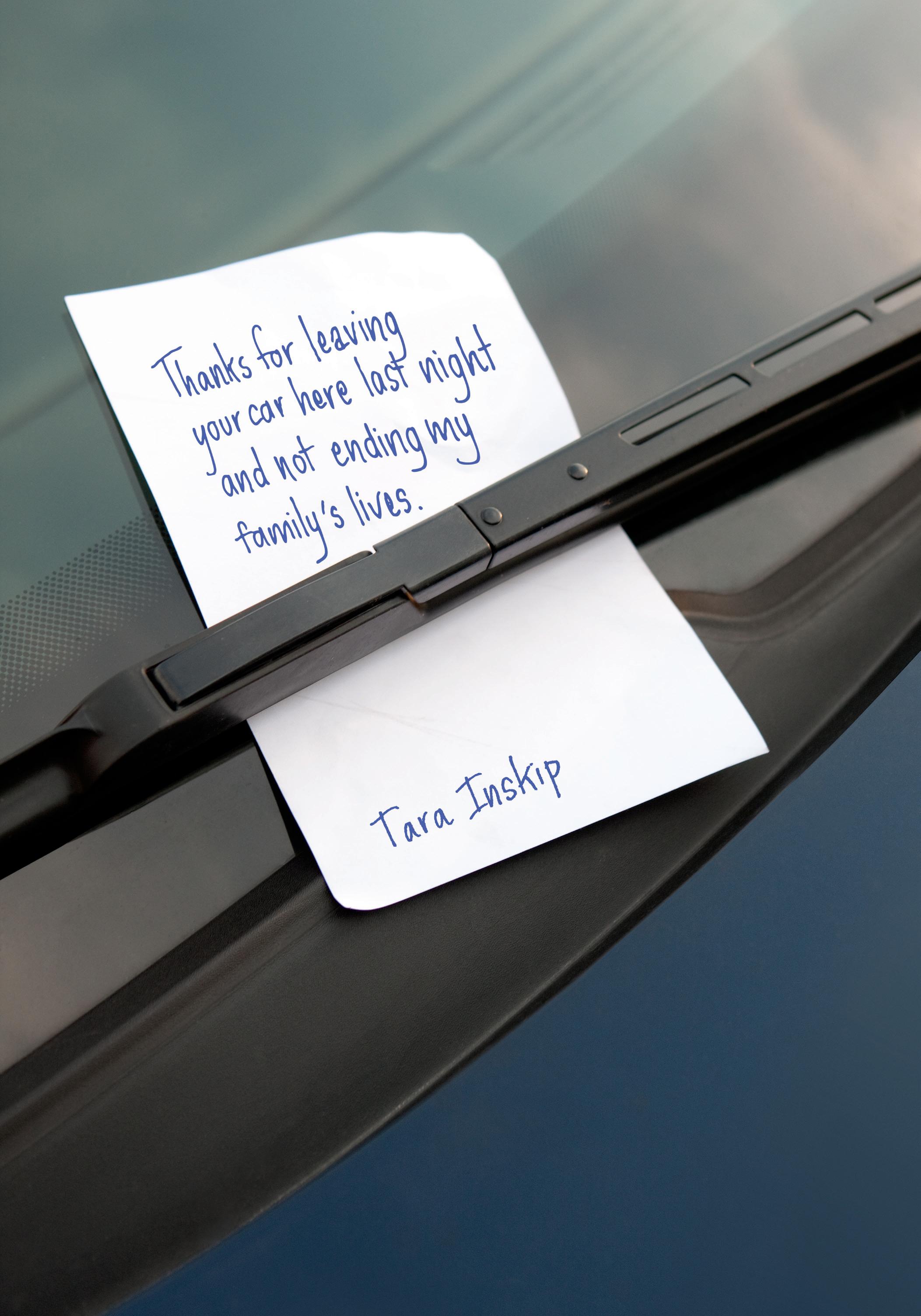
Save a life. Don’t D rive H o M e buzze D. BUZZED DRIVING IS DRUNK DRIVING.









Why we need neighbors
Communities are more important than ever. Here’s what that looks like in Columbia. Page 16

Save a life. Don’t D rive H o M e buzze D. BUZZED DRIVING IS DRUNK DRIVING.
Part of my job is to ask hard questions. So, here’s a fun one: Politically, socially and economically, how did we end up here?
Let’s start with the current state of things. Recession looms on the horizon amid the ever-increasing cost of living and a sluggish job market. The average age of a homebuyer in 2024 was 56 — an all-time high. And the political polarization of the Trump era has destroyed our sense of connection to each other and reality. According to the Pew Research Center, in 2022, 72% of Republicans and 63% of Democrats viewed the opposing party as more immoral than other Americans.
There are many things that contributed to how we ended up here. For starters, after World War II, the U.S. made the dollar the default international trade currency. While this bolstered national security and made the dollar strong, it made domestic manufacturing expensive in the U.S. This led to large-scale outsourcing to other parts of the world, which devastated working-class and industrial communities in America. This largely affected the Rust Belt and contributed to the rise of right-wing populism and resentment toward immigrants, who have been blamed for taking American jobs and resources.
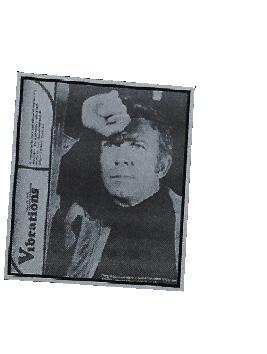
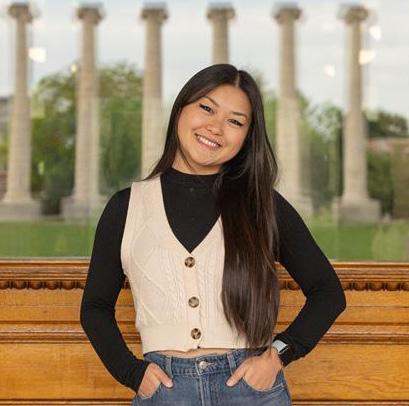

The truth is hard: The American Dream was based on the idea that if you worked diligently, you’d be able to own a home, support your family and live a good life. This dream is becoming increasingly less realistic. This is concerning for young people, who are realizing that this aspiration isn’t guaranteed and might never have been.
The most important part of the work journalists do is finding the people who are working to address these concerns. In this issue of Vox, we cover tricks for saving money (p. 34), focusing on how financial literacy can ease economic worries. We dissect how our culture shifts with the Dow, analyzing our society’s response to financial crises through recession indicators (p. 5). And the stories that resonate the most right now show how resilient communities can be during uncertain times, emphasizing the importance of what we can do for each other (p. 16).
So, what I ask now is not how we ended up here, but how we can all help our communities through hard times. Things don’t always need to be this way. Find the bravery to face your bank account. Say hi to that neighbor you see every day walking their dog. And know that, while the future sometimes seems bleak — it’s the small things that add up.

Cayli Yanagida Editor-in-Chief
Don Ranly taught tens of thousands of students and professionals how to write and edit clearly — through his classes, books and seminars. But to those of us in the magazine area of the School of Journalism, he’s also the reason Vox exists. Ranly, who led the magazine faculty from 1976 to 2004, died Nov. 10. He’d just turned 90. When he started at the school, the magazine was called, appropriately for the time, Vibrations. That later became two weeklies — Weekend and Ideas — which merged in 1998 to become Vox. He was a fierce advocate for magazines’ vital place in the media landscape and a champion of good grammar. His one-page “Ranly’s Rules” for punctuation has circulated the world via alumni and professionals who still refer to these rules as a reminder about where commas should go.

I came to the school after he’d retired, but he would attend class to critique issues of Vox and push us to remember the readers’ experience. He’d question whether text was legible (he’d surely say this is too small) or whether a headline made sense. And I still have his note on my office bulletin board of his seven C’s of journalism. It’s a reminder to be correct, consistent, clear, concise, coherent, complete and creative. He’ll forever be the voice in the heads of so many as we think about our work.
—Heather Isherwood
EDITOR-IN-CHIEF CAYLI YANAGIDA
MANAGING EDITORS AVERI NORRIS, ALLY SCHNIEPP
DEPUTY EDITOR AUSTIN GARZA
DIGITAL MANAGING EDITOR BRIANNA DAVIS
AUDIENCE ENGAGEMENT EDITOR CLAIRE WILLIAMS
ART DIRECTORS RACHEL GOODBEE, VALERIE TISCARENO
PHOTO DIRECTOR AVA KITZI
MULTIMEDIA EDITOR ARABELLA COSGROVE
PODCAST PRODUCER KIANA FERNANDES
ASSOCIATE EDITORS RACHEL GOODBEE, KATIE GRAWITCH, JAZMYNE MARTINEZ, BROOKE RILEY, CHARLIE WARNER, EMMA ZAWACKI
STAFF WRITERS DAVID ALDRICH, SOPHIE AYERS, ALLI BEALMER, GRACE DEEN, ALEX GOLDSTEIN, AUGUSTUS HENDERSON, MARISSA HORN, JASMINE JACKSON, SOPHIE LINDBERG, MATTHEW OSTHOFF, NEALY SIMMS, ACIYA EL TAJOURY, JACKSON WEST, TYLER WHITE
SOCIAL & AUDIENCE EMMA CLARK, CHLOE IRELAND-KILLDAY, NEALY SIMMS, PARIS SPENCER
DIGITAL PRODUCERS ALLI BEALMER, LUCIANA
DE ANDA, ABIGAIL DURKIN, JAKE MARSZEWSKI, CLAIRE POWELL
DESIGN ASSISTANTS ISABEL BRAUHN, LAUREN JOHNSON
CONTRIBUTING WRITERS MERCY AUSTIN, EMILY
EARLY, EMMA HARPER, GRACE ROMINE
CONTRIBUTING PRODUCERS ETHAN DAVIS, ALEX PEREZ
EDITORIAL DIRECTOR HEATHER ISHERWOOD
DIGITAL DIRECTOR LAURA HECK
WRITING COACHES CARY LITTLEJOHN, JENNIFER ROWE
FOLLOW US

WANT TO BE IN-THE-KNOW?
Sign up to receive Vox ’s weekly newsletter, the “Vox Insider.” We’ll tell you how to fill up your weekend social calendar and keep ahead of the trends. Sign up at voxmagazine.com.

CALENDAR send to vox@missouri.edu or submit via online form at voxmagazine.com
ADVERTISING 882-5714 | CIRCULATION 882-5700 | EDITORIAL 884-6432
DECEMBER 2025
VOLUME 27, ISSUE 9
PUBLISHED BY THE COLUMBIA MISSOURIAN LEE HILLS HALL, COLUMBIA MO 65211
Cover design: Valerie Tiscareno, Rachel Goodbee
Cover photography: Ava Kitzi
Cover illustrations: Adobe Stock
A pop culture crystal ball
TikTok on the clock ... is the 2008 recession making a comeback? 07 Vox Picks
Whether you want to vogue, pedal or flock, Columbia has something for you.
Charity is their headliner
With charity as its supporting act, Dead Jones continues to jam out for its causes.
Messy is the masterpiece
Adrienne Luther Johnson’s family heirloom is their artistic ability.
Circus in the city
After 47 years, the Hardnocks are still the fashion ringleaders.
Crafting community
Meet the Columbia spaces helping the lesbian community flourish.

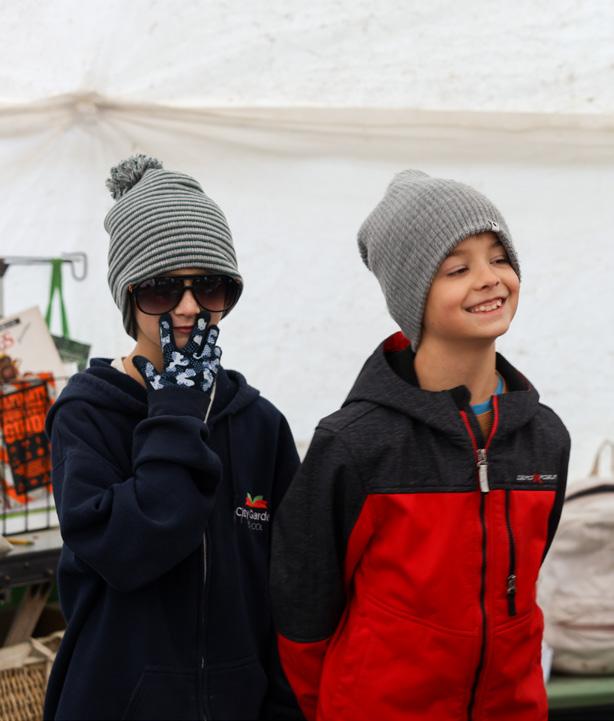
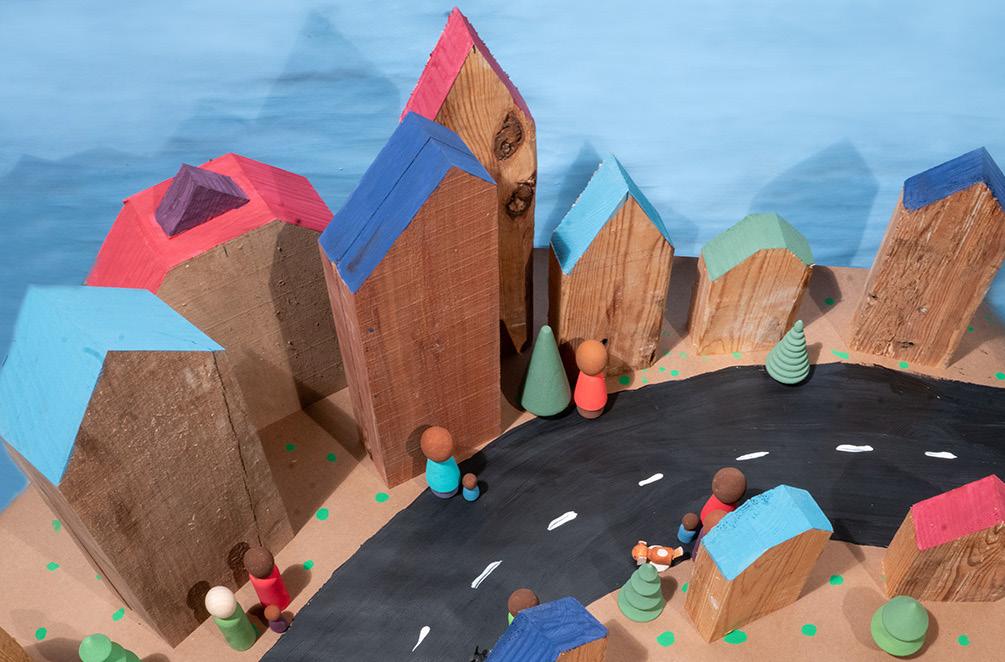
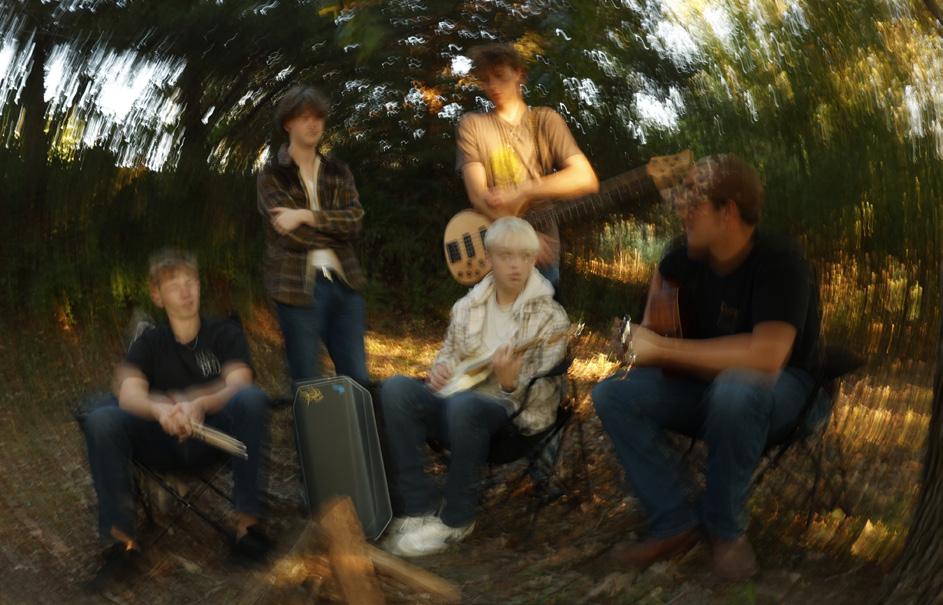
Won’t you be our neighbors?
Like these wise words from Mr. Rogers, Columbians are beckoned to be good neighbors to each other. But what does that mean?


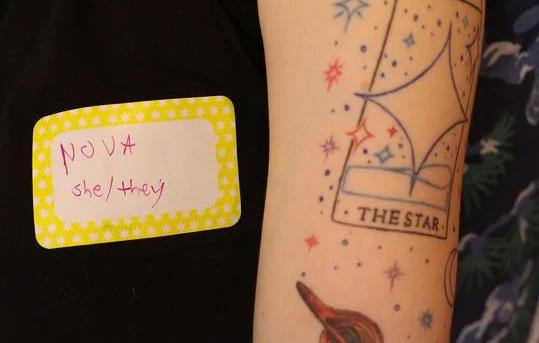
Three local shops put their own spin on recreating this viral trend.
Get the low down about falling STI rates in Boone County.
These sustainability programs aim to make eco-consciousness accessible for all children.
Make the most of your money with these tips from five local financial experts.












What do nostalgia and memes have in common? Both might be recession indicators — or much needed distractions.
BY ALLISON BEALMER
Every economic era has its soundtrack. Amid the financial woes of the late 2000s, radio stations had pop music on rotation. Lady Gaga danced through the downturn with synths, Kesha brushed off bad credit with glitter and even Lorde’s early 2010s minimalism felt like a hangover cure for the overspending from the night before.
Now, as whispers of another downturn float around in the form of recession indicator memes and rising prices, pop culture seems to be giving back that same energy. 2025 has seen short and natural nails return, thrifting is more popular than ever and singer-turned-actress Lady Gaga ended her pop hiatus with the comeback album Abracadabra
If pop culture history is any guide, the way we dress, dance and decorate might say just as much about the economy as any other index. While economists look over data points, the rest of us signal uncertainty through playlists and aesthetics. Pop culture could be hinting that we’re bracing for a vibe shift — if not a recession.
Nicolas Ziebarth, an economics professor at the University of Missouri, says economic recessions are defined as a decrease in the purchase of domestic products for two continuous quarters. “However, the technical definition of a recession allows for more discourse,” Ziebarth says. “As the National Bureau of Economic Research says, a recession can be defined as a significant decline in economic activity.”

Recession memes are the result of people seeing the rise in prices correlat ing to the return of early 2000s fashion trends and recession pop music.
“It’s kind of natural. (The memes are) something that’s tangible,” Ziebarth says. “It’s something that people under stand a little bit better versus some of these economic statistics.”
And it’s not just the return of differ ent fads that are causing this “recession indicator” mindset — it’s also the rising cost of living.

Isabella Martinez, a Columbia resident since 2018, lives in a duplex with friends. She has noticed similarities between the 2020 recession and now. “It just seems like a lot of things went up and never came back down like people said they would,” Martinez says.
Jeremy Hunsaker, a Columbia resident since 2008, is also feeling the weight of rising prices. He received a notice that rent for his townhouse will go up to $1,200 per month — almost double what it was in 2021 when he began renting there. If his original rent of $695 was adjusted for inflation, it would now be $816.14, according to the Consumer Price Index Inflation Calculator. Because of the increase, Hunsaker is leaving Boone County to live in a more affordable city.
“There are a lot of people who are in the situation I’m in that aren’t able to prepare for it in the same way,” Hunsaker says. “If you add that on to this rising housing (costs), and then you’ve got Thanksgiving and Christmas, you’re looking at kind of pulling the rug out from under a lot of people.”
So, amid a rising cost of living, what clues can pop culture serve up about the economy? Columbians offered their insights about how everything from nail trends to hemlines to pop music might — or might not — be recession in-




Karen Pummill-Neal, who calls herself “tie-dye Karen,” has been selling her own art since the 1990s. During the pandemic, she saw many





as her workshops are filling up.
“I think it’s because people need art in their life,” Pummill-Neal says. “To get regular art, like paintings, it can cost hundreds of dollars. But if you want, you can get a kit at Walmart for $20 or $30 and a couple T-shirts and satisfy that need for beauty.”
French tip
Simpler nails are another place where trend meets economy. The rise on social media of the so-called clean girl aesthetic has led to more French tips or easy press-ons instead of complex nails. Calling this a “trend” is inaccurate, though, since the look has been co-opted by white influencers from beauty practices common in Hispanic and Black communities. But the minimalistic approach is indeed cheaper.
Mia Kravitz, a nail tech and Mizzou student who started doing nails during the pandemic, says she first turned to doing her own nails for affordability but stayed for the creativity. “I was spending at least $130 a month getting my nails done,” Kravitz says. “Now all my products cost about $35, and that’s a one-time purchase.”
When talking about recession indicators, the Hemline Index is bound to come up. It suggests that skirt lengths correlate to the country’s economic health, with shorter hemlines matching the feel-good vibes of a booming economy and longer skirts indicating a downturn.
Sounds pretty cool, but unfortunate ly, it’s not true. Nicole Johnston, curator of the Missouri Historic Costume and Textile Collection, says fashion history shows that longer hemlines actually sig nal economic prosperity.
When the Hemline (miniskirts means maxi ones indicate a bust), women’s been floor length for centuries. Hemlines began to shorten in the late 1920s, just before the Great Depression. So at the time, the theory worked. While the skirt lengths did drop again later in the ‘30s, the Depression caused shorter hemlines due to an increase in fabric expenses.
way of communicating that you had the means to purchase abundant amounts of fabric.
‘Thrift Shop (feat. Wanz)’
From scrunchies to peplum tops to vintage sweatshirts, fashion has always been cyclical. Plato’s Closet employee Chiara Prenger says the resurgence of certain trends connects to the growing popularity of thrifting and the DIY creativity that took off during the pandemic. “It was like the world was falling apart,” Prenger says. “People were trying to salvage what they could to make it better.”
What began as a practical way to save money soon became an outlet for individuality and self-expression with upcycling. “I see so many videos of people going thrifting and then taking those items and learning themselves how to fix it,” Prenger says.
Talk about ‘Pop Muzik’
While early 2000s recession pop tracks are returning to the dance floor, Julienne Graebner, the general manager of The Social Room, says it’s less about another economic downturn and more about nostalgia and cyclical taste.
“ ‘Like A G6’ still fills the dance floor because everybody’s still going to be dancing,” Graebner says.
Rather than signaling another financial collapse, the resurgence of upbeat pop and Brat summer reflects collective nostalgia, shifting emotional landscapes and the timeless desire to dance. “Because (college kids) are younger,” Graebner says, “they probably don’t associate it so much with the original 2008 recession.”

Throughout history, long skirts were associated with the wealthy and were a


Pop culture might not be able to predict the next economic downturn, but it mirrors how people respond to uncertainty. Trends like minimalism, thrifting, DIY-ing and nostalgic pop music aren’t necessarily economic forecasts — they
Trends reflect how people seek comfort, control and creativity when the world feels unstable. And as the economy fluctuates, pop culture tells the story of how humanity copes when the future feels uncertain.




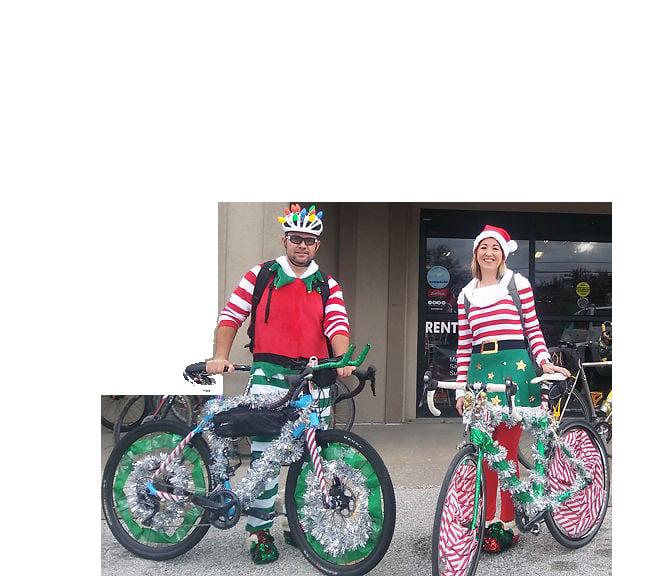

to the show at The Blue Note for the Celebrity Drag Show: Holiday Extravaganza. The Widow Von’Du, RuPaul’s Drag Race Season 12, hosts the event. The show will feature local performers and lots of holiday-related shenanigans. Additionally, there will be a meet-and-greet with a secret special guest. 8 p.m. Dec. 19, The Blue Note, $19.25-$31.60, thebluenote.com
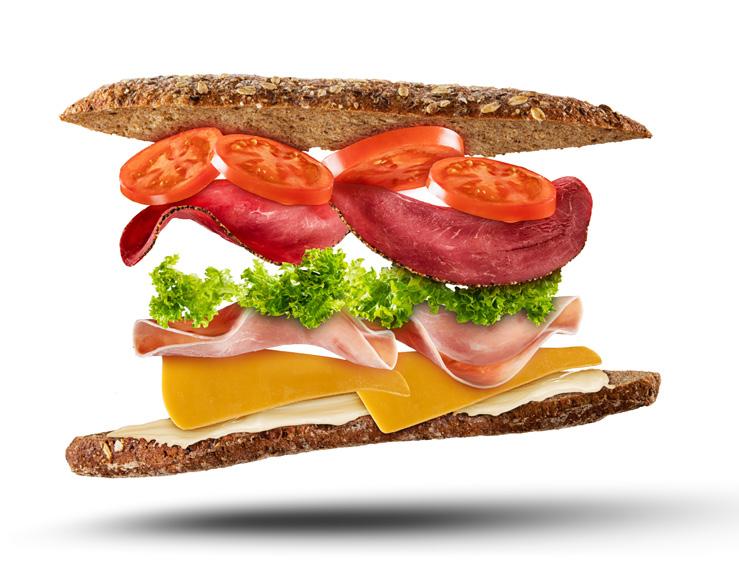
Flock to the grand opening of Birdie’s Deli when it takes over the former downtown spot of Seoul Taco in early 2026. Co-owners Paddy and Chelsea Jernigan draw inspiration from their favorite delis in St. Louis and elsewhere in the Midwest. The shop's bread and Italian cured meats will be sourced from businesses like Fazio’s Bakery in The Hill in St. Louis, where Chelsea is from. 2026 at 1020 E. Broadway Suite F, birdiescomo.com.
For Dead Jones, performing is more than the music — it’s a chance to give back.
BY GRACE DEEN
For the members of Dead Jones, their most important piece of show equipment isn’t a guitar or a microphone. It’s a piece of poster board and a Sharpie, which they use to write the words “Wounded Warrior Project” to display at their shows. This band doesn’t just play for an audience — it plays for a cause.
Although it could stand to lose the studio bills, rejected noise permits, flat tires, bad weather and other unforeseen obstacles that many new bands encounter, there is one element of Dead Jones that the members won’t be giving up: charity.
Joe Tyler, the band’s lead singer and guitarist, says Dead Jones is not bigger than causes like the Wounded Warrior Project, a nonprofit foundation that supports the physical and mental well-being of veterans. “We ended up raising $1,300 in two weeks for that organization,” drummer Colin Smith says. “It meant a lot with the cause being the Wounded Warrior Project because my dad is a disabled vet.”
Like many of life’s best things, the band began with an Instagram DM. Tyler found Smith’s profile on the Mizzou class of 2028 account in an introductory post that mentioned drumming as one of his hobbies. After agreeing to start a band, Tyler remembered that Ben Gilmore, who he met at a guitar camp years prior, also attended the University of Missouri. Then, Tyler met Ryan Seaton in an English literature class, and he became their next guitarist.
The final piece to the Dead Jones puzzle was found by luck. Smith overheard an acoustic guitar coming from Camden Whitney’s dorm room. When Whitney learned the band was looking for a bassist, he mentioned he played a
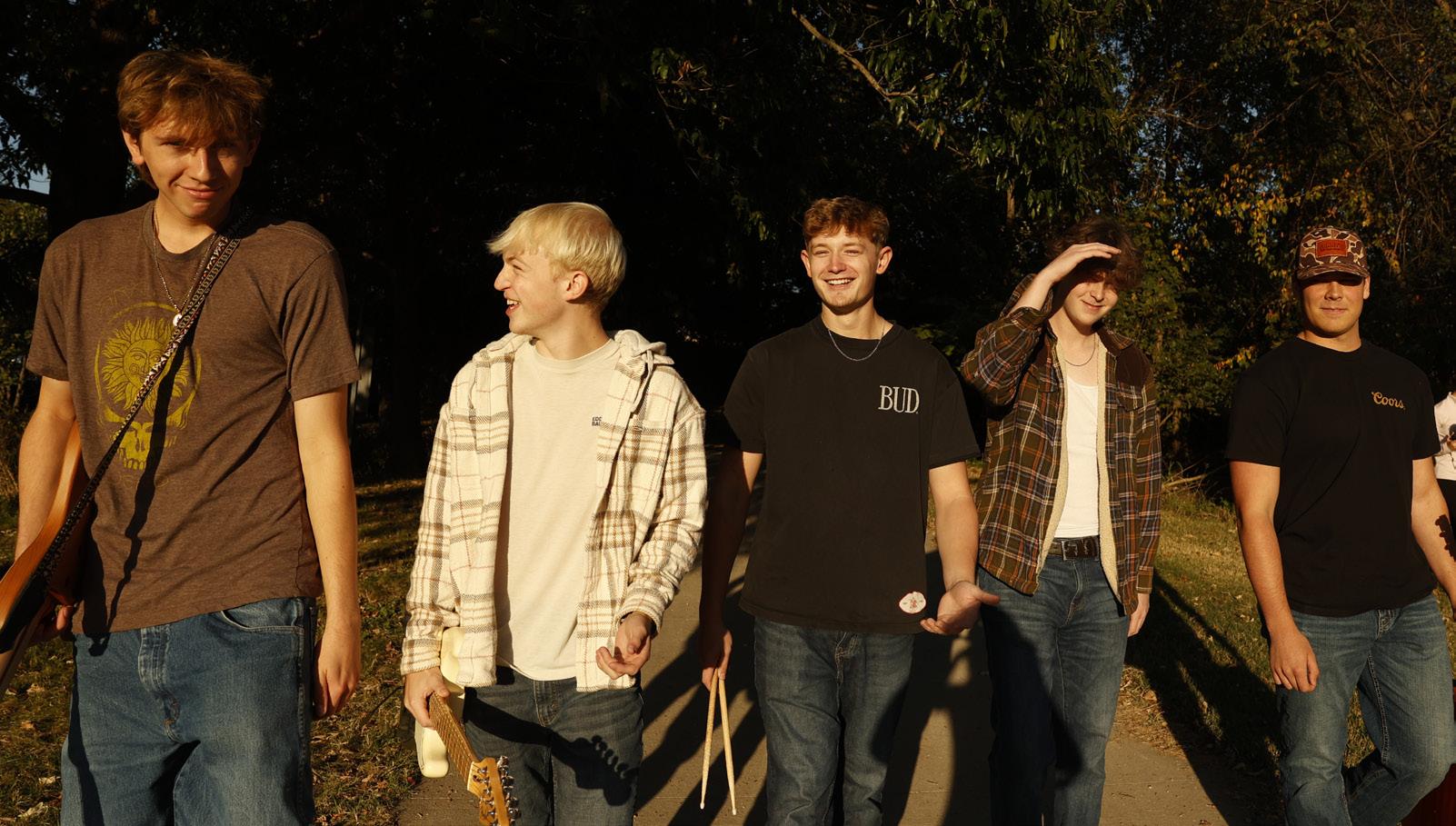
little bass. “I completely lied,” Whitney says. “I didn’t even have a bass guitar.”
The five of them didn’t know they’d be playing free gigs for charity. It started when the Beta Sigma Psi fraternity, which Smith and Whitney belong to, asked the band to perform at its fundraiser at Speakers Circle. “As a band that doesn’t have a name for themselves, playing a free charity show is a great way to have people see you — and you’re doing it for a good cause,” Tyler says. “It’s a win-win situation.”
Dead Jones has also played free gigs to raise donations for the Live Like Lou Foundation, which funds research and supports families affected by ALS. Being able to perform for a greater purpose is its own form of compensation during a time when the band wasn’t profiting. “Regardless of whether or not we had a connection to a specific charity,” Smith says, “we knew there was going to be a positive outcome for the cause.”
Mr. Write-side
Less than a year after the group’s formation, the band got to split some earnings after its first paid gig on Sept. 13 at Sky
Dead Jones describes itself as a mix of country and indie rock music, covering songs like “Free Bird” by Lynyrd Skynyrd. It’s members include (from left) Camden Whitney, Ryan Seaton, Colin Smith, Joe Tyler and Ben Gilmore
Find information on upcoming shows, as well as videos and photos of live performances on the band’s social media platforms. The band is active on Instagram, TikTok and YouTube, all using @deadjones theband.
Music Lounge in Ballwin, and they’ve only grown from there. On Oct. 4, the band opened for rapper Lil Skies during a GreekFest performance. Tyler says it was the biggest crowd the band had played for.
Calling the band one of her favorite clients, Kiley Grimes, owner and founder of Soundcheck Practice Studios, says she is excited to see where its success takes the band. “They have this really unique band chemistry you don’t see often,” Grimes says. “You could tell they were all about their music, through and through. They eat, breathe and sleep it.”
Grimes’ studio is one of the few places where the band has performed its original music, which it hopes to release in the future to move away from playing cover songs. “We have so much more passion for something we wrote,” Tyler says.
No matter what direction the band takes, Smith says they’ll prioritize charity performances. “As long as there’s an opportunity, nine times out of 10 we’re going to take it,” Smith says. “They turn out to be some of our most fun experiences.”


From Cafe Berlin to Cooper’s Landing, Adrienne Luther Johnson inspires creative chaos.
BY JASMINE JACKSON
Adrienne Luther Johnson loves creative messes — empty canvases never stay blank and every paint stroke is encouraged. Instructions don’t exist besides one important goal for artists: create a mess. However, those creative messes don’t always manifest in freelance work. Whether it’s the mural at Flat Branch
Park, the T-shirts at Acola Coffee Company or the paintings hanging from the walls of Cafe Berlin — where Adrienne is the marketing manager with her husband, Sam Johnson, who co-owns the cafe — her projects often come with a plan.
Even so, Adrienne finds a way to get
Adrienne Luther Johnson’s sister, Claire (above right), also participates in the family’s artistic legacy by helping touch up the mural at Locust Street Elementary School.
messy and have fun with art, while teaching young artists, specifically children, to do the same at her pop-up classes. Normal class structure is thrown out the window, allowing creative chaos to thrive. She calls it a form of art education, but she didn’t learn it in a classroom.

It comes from a more personal source: her mother, Suzanne Luther, who is a former Jefferson City art teacher and current member of the Board of Education (she’s also running for election in Missouri House District 60). “One of the lesson plans she had was you’re not allowed to use an eraser,” Adrienne says. “That stuck with me because as a kid, I remember thinking I need to erase. She said, ‘You have to keep going. Just draw lighter and then darker as you get more confident.’”
There are no rules other than to not erasing — just create and accept your artistic mess as it is. Growing up with this artistic approach as a child has helped to shape Adrienne into the artist she is today, and now she’s hoping to inspire the next generation to create in the same way she did.
Bring on the mess
Every Saturday this past summer, Adrienne scattered art supplies on the benches near the river for Crafts at Cooper’s with Adrienne Luther. This was her second year of pop-up art classes at Cooper’s Landing that were open to all ages. The play-based event had no strict lesson plan.
This was a bit of a challenge for DeAnna Anglin, who brought her two young sons to Cooper’s this past year and painted alongside them. She noticed how the event helped her son deal with self-criticism and frustration when making a mistake. Now, he just keeps painting.
For her, it took a second to see the personal benefits. “It can be nerve-racking at first, but that freedom of (letting) your paintbrush, marker or crayon go
Adrienne Luther Johnson says that her mural career kicked off during the pandemic, and since then she has been doing freelance and design work throughout Columbia.
wherever on your paper is liberating,” Anglin says. “It may not look like what you want, but the journey is where the important stuff is.”
While Crafts at Cooper’s will return next summer, Adrienne says families and individuals can still foster creativity by “learning to play and taking (art) less seriously.” She hopes it will “pass on generationally,” just as it did for her family. After all, the creative mess traces further back than just one generation. It’s a family tradition that spans across four generations, cultivating a long line of female artists.
Tracing the line
All the women in Adrienne’s family, from her great-grandmother forward, are artists. Within the family, almost no medium is left untouched.
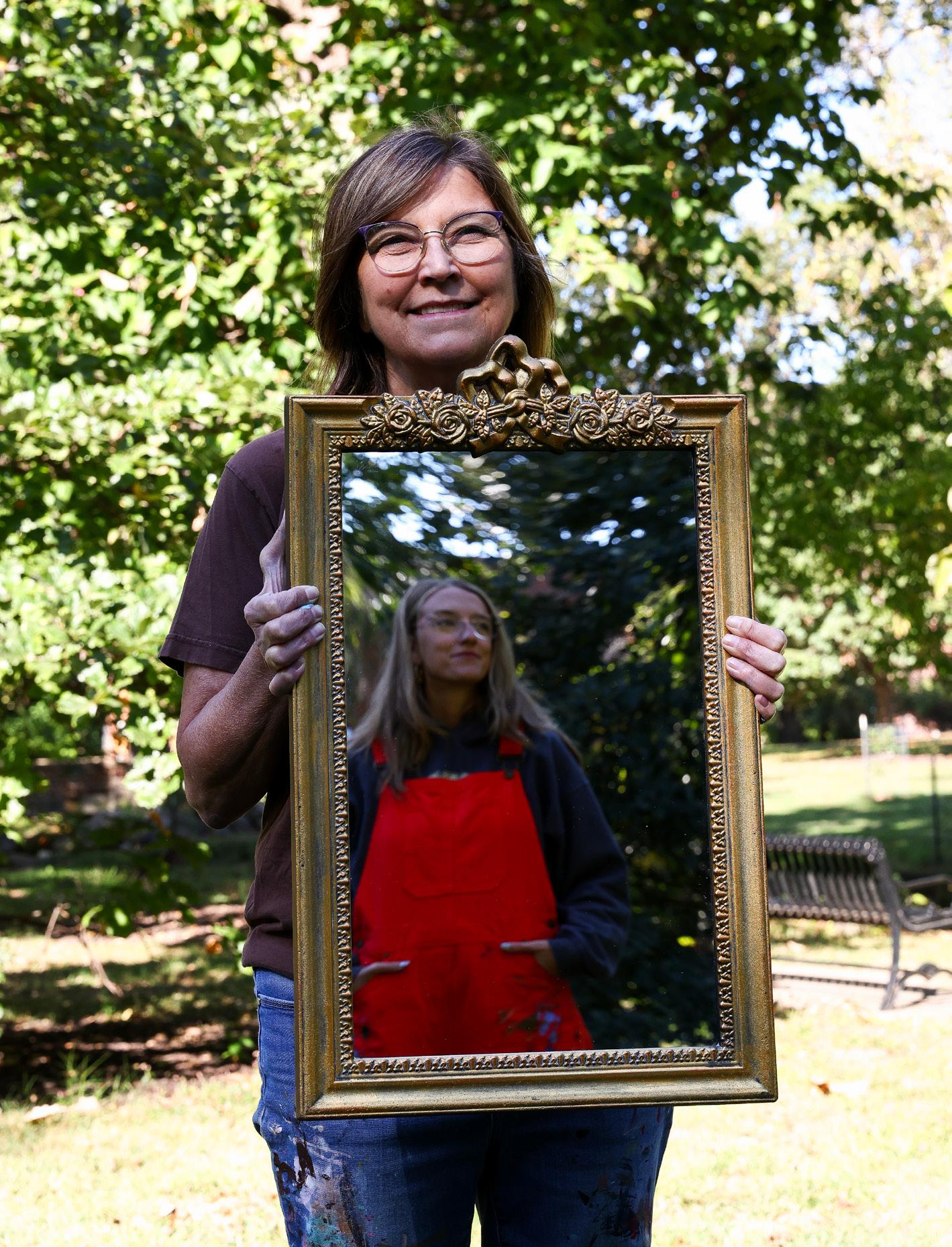
Kathleen, Adrienne’s great-grandmother, quilted and taught her daughter Glenna (Adrienne’s grandmother) how to sew. Glenna became a seamstress, and she made the family dolls, embroidery, cosplay and Halloween costumes. Her daughters loved different mediums: Ladonna, Adrienne’s aunt, is a mosaic artist. Suzanne paints and draws.
Despite the varying mediums, being messy was always a part of their childhoods. Ladonna remembers decorating cookies as a child, an activity she later did with her own children. “We made horrendous messes: food coloring and colored sugar everywhere,” Ladonna says. “That was fine with (Glenna), as long as we were being creative.”
Suzanne took the same approach
Photography by Kate Cassady
when raising Adrienne, even if it meant accepting the large black letters written in Sharpie on the carpet. “I wasn’t happy about it, but I viewed it in the same way my mother did: It made me happy to see my kids be creative,” Suzanne says. “We’d clean up the messes, and then they were not a big deal.”
For Adrienne, messes are more than just a form of self-expression. It’s a connection to the women in her family. “The power of having that healthy, maternal energy carries through my artwork,” Adrienne says. “It’s all rooted in womanhood, my experience as a woman and what I can learn from the women before me.”
Adrienne hopes creative messes will remind artists of all ages and experience
Suzanne Luther (left), who raised Adrienne and her sister to express themselves through various mediums, is one of the people Adrienne Luther Johnson says she connects with through art — she does so with all the women in her family.
Adrienne Luther Johnson’s community collaboration doesn’t end with her current murals and summer popup classes. She recently completed murals at Porchfest in Jefferson City for the city’s bicentennial and at Clover’s Natural Market for its 60year anniversary celebration. She also did a Greetings from Columbia mural for Access Arts. Additionally, she is planning for more pop-up classes at Cafe Berlin in the winter.



The dragon mosiacs (top and bottom) are Ladonna Luther’s work. Several of her pieces center around one theme: dragons. The middle piece is Suzanne Luther’s piece “Tree.”
levels that art doesn’t have to be about rules. It can be playful or unserious, wild or carefree. “Art is my greatest form of therapy, so I hope it inspires people to find refuge in a creative outlet. I feel like now more than ever we need that,” Adrienne says. “If I’m able to even facilitate that in just one child, that’s enough for me.”
Celeste Hardnock, joined by her daughter, Stella, has led this Broadway boutique for nearly 50 years.
BY NEALY SIMMS
Stroll past this stand-alone building on East Broadway, and the panoramic windows of My Sister’s Circus offer an impromptu invitation to enter, reflected in the eyes of poshly posed mannequins. Inside, the curated racks of garments and multitiered display cases of twinkling trinkets only begin to tell the story of the boutique’s nearly 50 years of stylish success. The real secret behind its longevity lies in the work of its owners, mother-daughter duo Celeste and Stella Hardnock, who are dedicated to creating a lasting impact — one smile and sparkle at a time.
Discovering her niche
In the 1970s, amid the rise of boho chic with its earthy suedes and billowing bell-bottoms, and the flashy flamboyance of disco glam, Celeste’s dorm room at Stephens College became a fashion mecca for friends looking to make the
streets of Columbia their runway. “I was pretty much the go-to girl to put outfits together,” Celeste says.
The initial push to create her own retail space came from a friend, who insisted that Celeste utilize her keen eye for curation. “ ‘This is your niche, putting things together,’ ” Celeste says the friend told her. “It just clicked in my head, and I thought, yeah, maybe this is kind of fun.”
To break into the fashion industry after graduating from college in 1977, Celeste began by creating visually appealing product arrangements at various stores across Columbia. While working for Warren and Patricia Dalton at Suzanne’s, a former women’s clothing store on East Broadway, Celeste had the opportunity to market their products. This experience ignited her desire to open up her own store. But when a friend called to tell her about an open
My Sister’s Circus is open from 12–4 p.m. Tuesday through Friday and 12–3 p.m. on Saturdays. You can shop online at mysisterscircus. com or visit the duo in-person at 1110 E. Broadway.
Celeste Hardnock (left) taught her daughter Stella one important lesson, which is to always be authentic toward the customer. “We can’t sell something we don’t love, and I learned that from her,“ Stella says.

spot downtown, she still wasn’t sure. She credits her father’s words of encouragement, “you’ll never know until you try,” for convincing her to open My Sister’s Circus.
At only 20 years old and recently married to her late husband, Walter, Celeste admits she didn’t know anything about managing a business or even how to work a cash register. To hone her craft, she hired staff she had previously worked with and mimicked their techniques. “I still think you don’t learn until you do it,” Celeste says. “You can read it from a book, you can have people tell you, but until you actually get in that door and you physically do it, you’re not going to learn it.”
From the first day My Sister’s Circus opened its doors in 1977, Celeste fought to see her boutique succeed, even amid negative noise from people who said she wouldn’t make it six months. Such criticism just made her want to prove them wrong. “That was what drove me,” Celeste says. “My whole world revolved around making sure that this place succeeded.”
In 1985, when the Columbia Mall opened, Celeste faced the challenge of distinguishing her store from chain retailers. “Our calling card at that point wasn’t so much that we had better stuff,” Celeste says. “We had better customer service, and I mean, we worked it.”
For years, Celeste operated My Sister’s Circus alone with the help of a handful of employees. But when her only daughter, Stella, expressed interest in joining the business after college, Celeste made an unconventional choice by initially telling her no. “I wanted her to work at some place other than for her mom, where she could see this is how business
has to be,” she says. After graduating from college in 2003, Stella went to work at JCPenney, learning the ropes of retail on her own. Eventually, after one of Celeste’s main employees left, Stella called her, and soon they became colleagues.
Stella, who has now worked at the store for nearly 20 years, says she brings a younger perspective to her mother’s curated inventory. Their approach to sourcing, mainly from distributors in regions such as Canada, reflects this dynamic perfectly. “I like things that are really edgy, and my daughter likes things that aren’t quite as edgy, so it’s a good meet in the middle,” she says.
While Celeste keeps handwritten sales records in notebooks, Stella manages the store’s minimal social media presence, posting items and facilitating online sales through direct messaging and porch drop-offs. “We get along real well,” Celeste says. “She’s as much of a stickler on customer service as I am.”
Brooke Asmussen, an employee at My Sister’s Circus since 2009 and a witness to the partnership’s evolution over the years, initially worried about inserting herself into a family dynamic. But over time, her bond with the Hardnocks grew stronger. “I’ve become family in the time that I’ve been there,” Asmussen says.
Style, service and showing up
Walk into My Sister’s Circus any day during its store hours, and you’ll find yourself captivated by a wide range of items that could only emerge from
swinging open the doors of Barbie’s closet. It features a vast array of hyperfeminine, playful yet versatile silhouettes and accessories. The magnetic visual charm of each small detail — ranging from an enormous pink nutcracker statue, iridescent knick-knacks, a framed caricature drawing of Celeste and Stella and even a lifelike mannequin at the store’s center with outfits that change through the seasons — embodies Celeste’s philosophy that flaunting a little bling attracts onlookers in. “What My Sister’s Circus is, is like a gathering place for characters from the circus,” Asmussen says. “It’s a bunch of different minds gathering in the same place with a like-minded goal of finding something fun and fashion-y.”
While Celeste is in charge of the intricate curation, Stella has found her calling in the buying side of the business. “My mom has always been the master at displays, and I cannot do them to save my life,” Stella says.
The store attracts a particular type of customer, which Asmussen calls “fancy little birds” who are searching for something different. “We’re usually getting a gal with a perspective already; she’s already got some kind of something going on,” she says. “We are there to fill in the little cracks. You need some sparkle, you need a feather, you need a leather — we are there to facilitate whatever that extra bit (is).”
One principle Celeste holds above all others is the importance of being present in your own business and creating loyal relationships with customers.
“So many of these gals have been com-
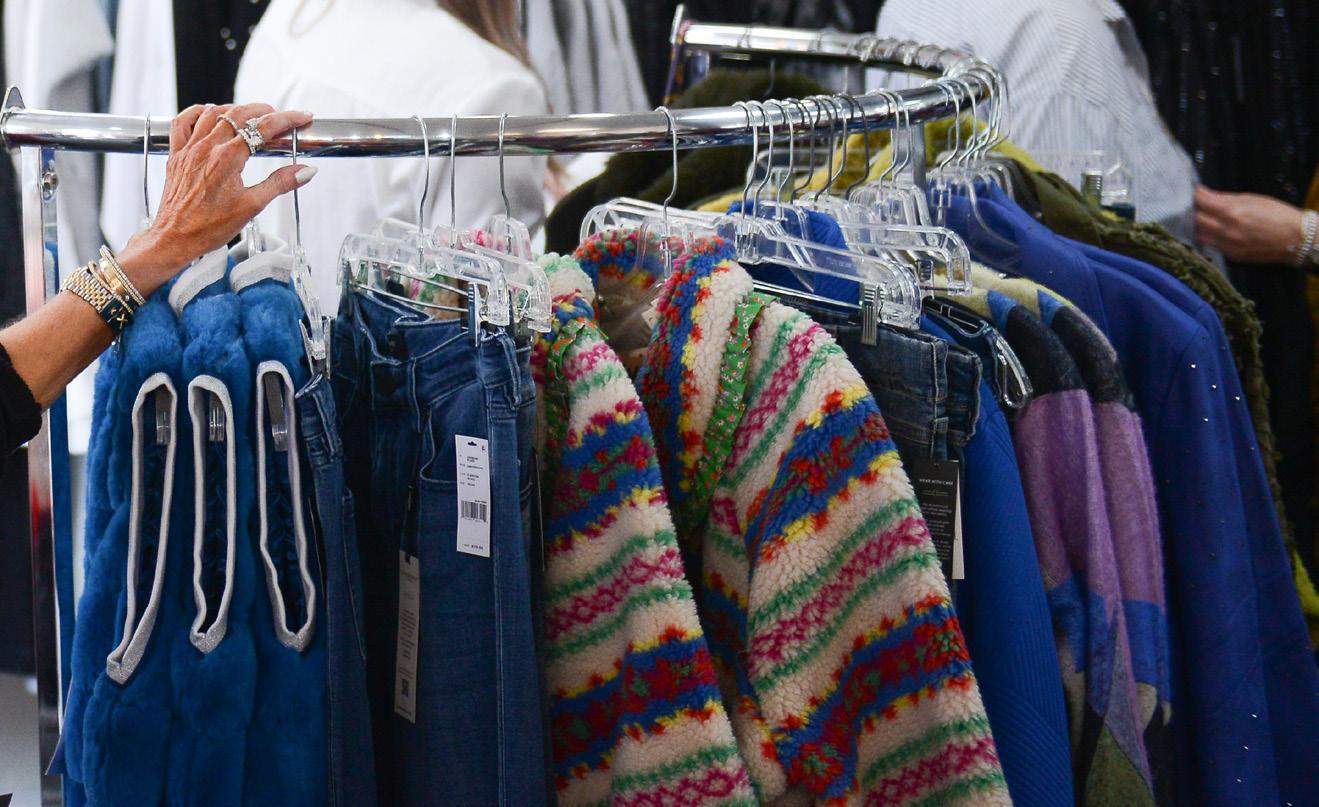
Photography by Ava Kitzi
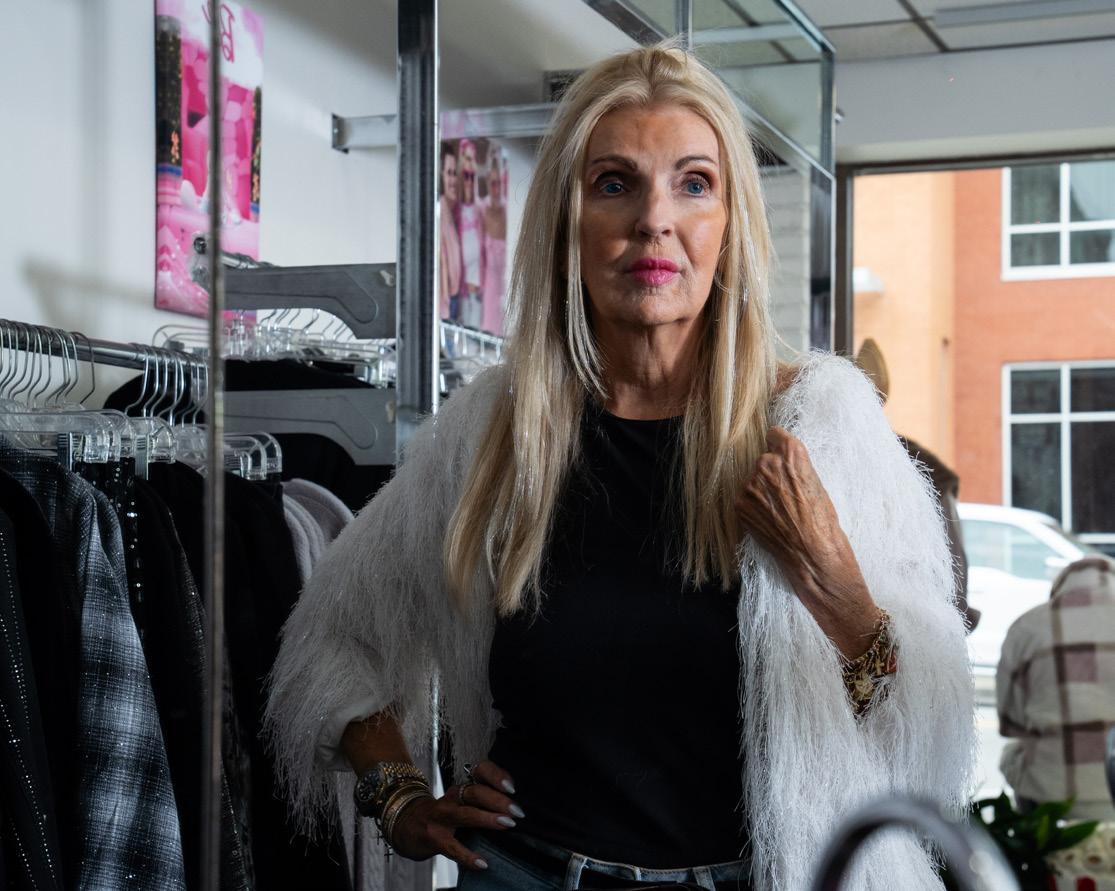
Celeste says that 90% of her store’s clothing is curated from her own eccentrically bold and confident style. “Not everybody wants to dress like I do,” she says. “But they have to be able to look at me, or look at the other girls and say, ‘They know how to put an outfit together.’ “
ing in here for almost 50 years, so we have all kind of aged together,” Celeste says. “They just like to come in and hang out because they get a good vibe, and to me that’s a big compliment, that’s almost a better compliment than saying ‘I just love your things.’ ”
After nearly 50 years, Celeste shows no signs of slowing down. What started as one woman’s leap of faith became a testament to perseverance. “It amazes the heck out of me that I’ve done something this long in the same spot,” she says. “It speaks volumes about being so dedicated to something that I was not going to roll over and, so many times I could have, and possibly should have, but I couldn’t.”
For Stella, witnessing her mother’s dedication has been transformative.
The duo may have different styles, but they share a love of glitter, fashion, fun and customer service. “We have glitter all throughout our hair every day, and something is sparkling on us regardless,” Stella says.
“My mom is such a vibe, and she’s such a fashionista,” Stella says. “This is her baby here, and her passion.”
While My Sister’s Circus has solidified its spot as a Columbia fashion landmark, it also serves as a glittering reminder that success in retail doesn’t require establishing an online presence or bowing to commercial retailers. Sometimes, it just takes showing up, being true to who you are and creating a space where fashion fanatics can gather. “The expectation is always different, and that’s the fun of it,” Asmussen says. “You never really know what you’re getting at the circus.” And that, perhaps, is precisely the point.
As attacks on LGBTQ+ rights continue, CoMo Dykes and Lesbian Memory Makers offer queer safe spaces with conversation and crafts.
BY MARISSA HORN
Over the past year, the pushback against LGBTQ+ rights in the United States is almost too extensive to quantify. The American Civil Liberties Union is tracking hundreds of anti-LGBTQ+ bills nationwide. Health care and suicide hotlines are on the chopping block, and queer history and information is being censored from government websites.
For those in the LGBTQ+ communities, finding safe spaces is more important than ever.
In Columbia, two new organizations, CoMo Dykes and Lesbian Memory Makers, have emerged to provide safe spaces specifically for lesbians and trans women. The groups join Lesbians Over 60, hosted by The Center Project, which has been active for about two years.
Columbia has a long history of host-

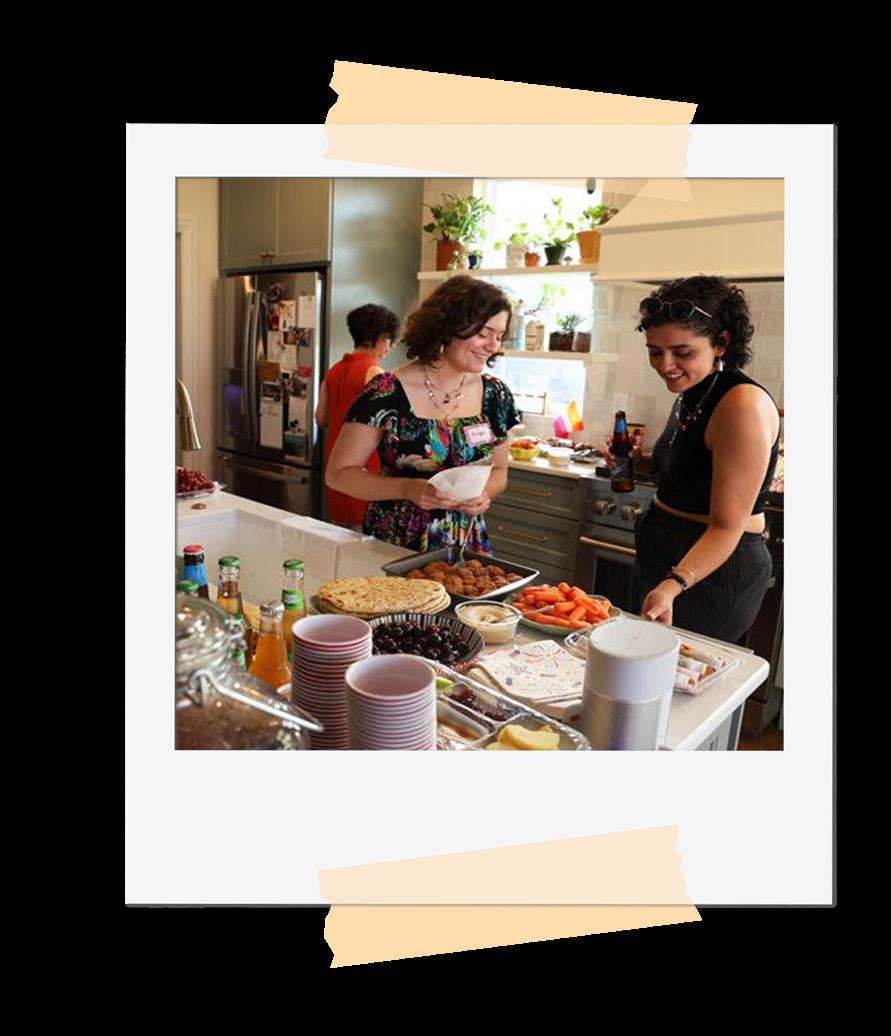

ing safe places, which are essential to the queer community. Queer safe spaces and third places are locations where individuals who are part of the queer community can comfortably exist outside of work or home, a concept that has been around since the 1920s, according to Xtra Magazine. These spaces take a variety of forms, from lounges such as The Social Room to groups such as Nclusion Plus. For many queer people, especially those who have faced isolation or discrimination, these spaces are essential for building identity, culture and fellowship.
A need for community
CoMo Dykes and Lesbian Memory Makers both aim to provide community for local lesbians that doesn’t involve nightlife activities
Joanna P. Peña, the organizer of CoMo Dykes, wants to encourage community and bring more queer representation to Columbia because of recent attacks to LGBTQ+ rights.
“I am a lesbian, and I am a person of color, so I know that things are getting complicated in the U.S.,” Peña says. “They are targeting trans people first. That means people — like conservatives and people that are transphobic — they’re going to take the loss, and they’re going to think now it’s (OK) to be transphobic and homophobic.”
Lesbian Memory Makers, organized by Daisy Florence, had its first event in
“I think we are never safe,” Joanna P. Peña says. “That’s why we need to get together and be organized.”
Lesbian Memory Makers is 18+ and posts its once-amonth meeting on Instagram @lesbian memorymakers. The meetings include crafts, such as scrapbooking, junk journaling, zine making, art, coloring books and more. CoMo Dykes posts on Instagram too, @lesbiansinunity como, where you can find its meetings and activities.
Maggie Ribaudo (left) attended a meeting hosted by Peña, who organized CoMo Dykes after noticing a lack of lesbian community.

July and has gathered once a month since. This queer space connects lo cal lesbians through their passion for arts and crafts. Florence developed the idea of a lesbian craft group after a trip abroad.
“After traveling to Japan earlier this year and seeing the queer communities thriving in smaller towns in Japan, it really made me want a community I could relate to and interact with that doesn’t involve things that are harder to participate in,” Florence says.
Florence’s group is COVID-conscious and encourages people to learn about the effects of long COVID, something she has had to face. Masks are required to participate, but creativity is where the group thrives.
“That’s what it is — it’s a crafts group for lesbians, so they bring whatever they want or use the supplies that are there,” Florence says. “Just two hours or so, once a month, where you can talk about anything, just being in a community with lesbians.”
Sophie Rodriguez, a member of Lesbian Memory Makers, moved to Columbia this past summer and says she has found the potential for friendship through the group. “I do enjoy that we can also be together in a room just working on our projects,” Rodriguez says. “It’s a space where we’re around each other and there’s no pressure to be one thing on our own.”

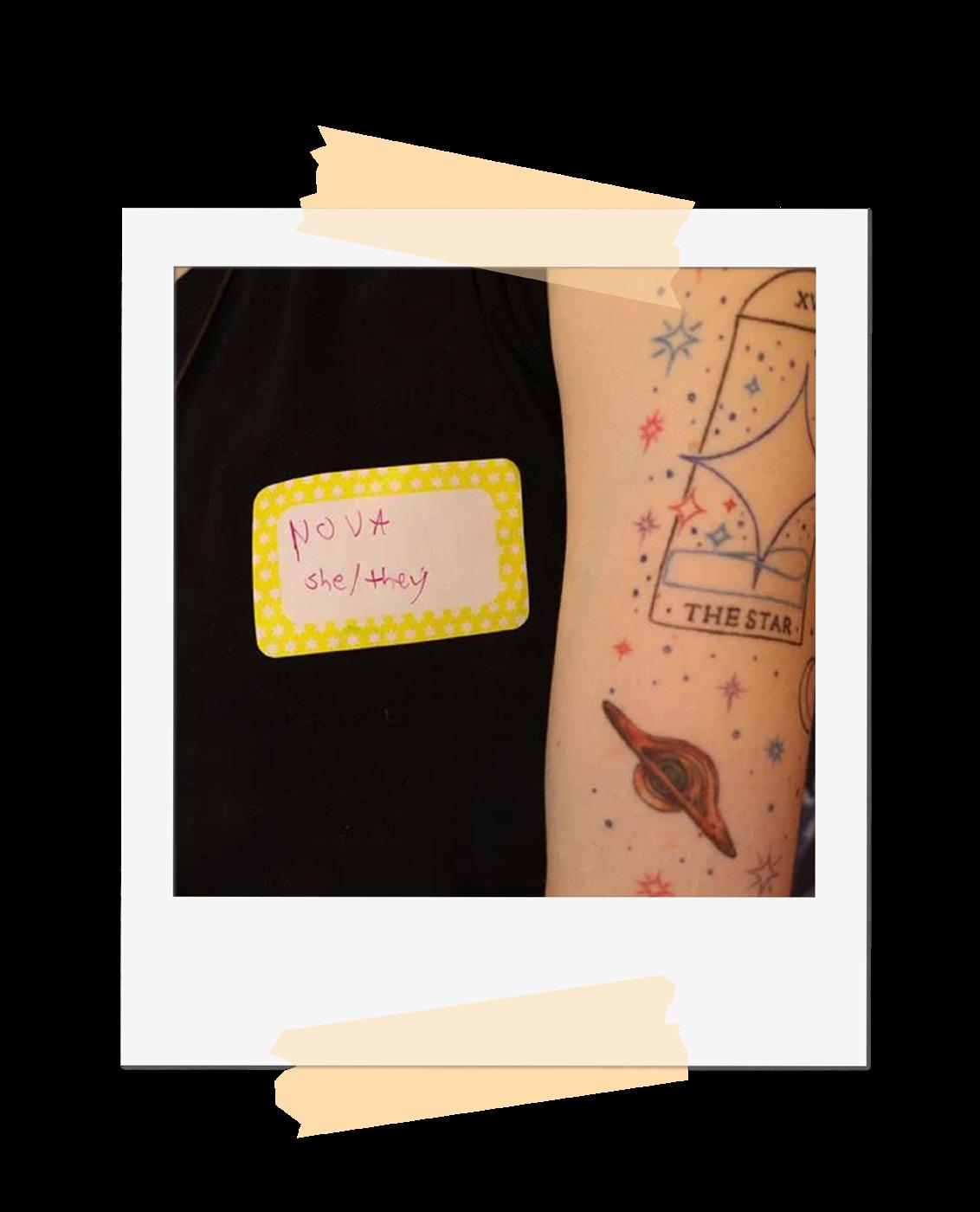



What makes these organizations even more valuable to the queer community is that they’re both trans-inclusive at a time when governments have sought to strip trans individuals of gender-affirming care, legal recognition and more.
Nova Matzel, a trans woman who is involved with CoMo Dykes, says she is concerned about the pushback on her individual rights and that funding for trans-related care is being stripped away. “Right now, we are actually extremely at risk of losing our health care,” Matzel says. “(It) is really concerning, especially as a trans person. It’s difficult to be able to rely on the government because we are very much at risk.”
Matzel started attending CoMo Dykes events hoping to build new connections and find a safe and affirming environment.
“I’ve been wanting to meet other lesbians,” Matzel says. “It’s a little hard to meet queer people in Missouri, mainly because it feels like there are not a whole lot of us out here. I just wanted to meet other people who were just like me and that I could find community and safety with.”
Ellen Dugger, who’s part of the Lesbians Over 60 group, has played a role in representing and advocating for
college years at the University of Missouri along with Bonnie Osborn, a 1994 Missouri School of Journalism graduate. Osborn says that group was a valuable part of her college experience and led her to meeting her spouse.
“When you go into those spaces you can let your guard down,” Osborn says. “You don’t have to worry about who’s next to you looking at you, looking down or giving you the side eye because of how they feel about your lifestyle or who you are.”
Since the 1970s, Columbia has seen many gay bars and other safe spaces open and close their doors. The now-shuttered clubs Contacts, Styx and Three Cheers offered spaces for the queer community before the 2000s. When Three Cheers’ lease expired, the LGBTQ-friendly Arch & Column Pub took its place. Other clubs also came and went, including downtown’s SoCo Club and Yin Yang Night Club, which celebrated the drag community.
In Ashland this fall, the owner of the Dandy Lion Cafe feared she would be forced out of the welcoming LGBTQ+

At CoMo Dykes meetings, guests are encouraged to wear name tags (top left) with their preferred names and pronouns.
Lauren Blake (top center) is one of the organizers of the events.
Daisy Florence (above right) says that people not a part of LGBTQ+ communities can provide support by lifting up marginalized voices.
space she had built when the lease came to an end. But on Oct. 23 — two days before what she’d thought would be the cafe’s last day — she shared that she was in negotiations for a long-term lease.
That’s why the emergence of groups such as CoMo Dykes and Lesbian Memory Makers represents more than just two new social networks. They create resilience in a time when LGBTQ+ rights are being targeted.
“We need a community to stay alive and stay well and stay strong,” Peña says. “I know that a lot of people want a space where they can live freely. So, I hope this small community is the first one of a lot more.”

Photography by Ava Kitzi

Written by Sophie Ayers, Allison Bealmer, Alex Goldstein, Nealy Simms and Tyler White
Designed by Rachel Goodbee and Valerie
Tiscareno
Edited by Katie Grawitch and Brooke Riley




When was the last time you borrowed a cup of sugar from your neighbor or shoveled someone else’s driveway?
The role of the “neighbor” has become increasingly diluted. As walkable neighborhoods disappear and technology keeps us behind closed doors, it’s easier to overlook the flower beds in the cul-de-sac or the sidewalk litter that magically disappears overnight. Yet behind each detail of a neighborhood is a network of people.
There’s also the influence of policy decisions, from what areas are preserved to the racial and economic chasms that have shaped who lives where. In an era of multiple community challenges — from cuts to affordable housing to the targeting of some people by immigration agents — many are left to rely on friends and neighbors for support.
This got us thinking about the iconic Fred Rogers and the question he asked during three decades of Mister Rogers’ Neighborhood: “Won’t you be my neighbor?” Rogers also famously advised his young viewers to “look for the helpers” in times of crisis as a way of focusing on hope. Similarly, amid a world that feels chaotic for many Americans, focusing on our immediate community can again provide hope. In this package of stories, Vox writers explored the many ways that community takes shape here in Columbia.



From preservation to community improvements, there’s a lot we can learn from our neighborhoods.
BY TYLER WHITE


The division of cities into neighborhoods is synonymous with civilization, with roots going back to ancient Mesopotamia. But neighborhoods are more than a geographic location — they matter because of the communities they create among the people who live there.
Such boundaries cut both ways — with some in American society able to choose where they live while others cannot. Divides along racial and economic lines influence who lives where, whether through historic institutional discrimination, such as redlining, or current realities of affordability. There are a myriad of issues that come into play based on where we live.Which communities are leveled in the name of urban renewal or gobbled up through eminent domain? Where is it assumed that you’ll know your neighbor? What places are preserved, decorated and desired?
Psychologist Samantha Stein says

Party on the block
Putting together a block party might seem intimidating, but you can get the ball rolling with a few forms and fees. Visit the city of Columbia website and fill out a special event permit application linked under the Apply Now section. Pay the $25 processing fee and provide an event map that indicates the event boundaries.
Closing the street requires a street closure petition with authorization from any property owners or landlords who will be affected by the closure (both within and next to the event). The street closure comes with a $100 fee. Sophie Ayers
being a part of a healthy community is important to support us both physically and mentally. If we can rely on community members when we’re going through a tough time, they can help boost our well-being.
Yet so many people struggle to connect with our neighborhoods. According to Pew Research Center, in 2025, only about a quarter of Americans know all or most of their neighbors, and 12% don’t know any of them. That’s down from 31% of Americans in 2018. According to an article from Reader’s Digest, a community is the “cheat code to a good life.”
So, how do we get access to this cheat code in Columbia?
The roots of neighborhood history
There is a rich history of preserving some, but not all, Columbia neighborhoods.
Old 19th century houses like the Greenwood Heights home on Mexico Gravel Road or the Maplewood Home and Grounds at what’s now Nifong Park
have notched themselves in history as part of the National Register of Historic Places. Along with the brick streets and Victorian and collegiate gothic architectural styles, there is a storied character that enriches Columbia’s neighborhoods.
For Elena Vega, board member and president of CoMo Preservation, these historic locations tie the community together. It is necessary to preserve these homes because these historical roots add character to the neighborhood.
Take the house affectionately called the “Hansel and Gretel House” on the corner of West Ash Street and West Boulevard. “If that house disappeared, everybody would just be heartbroken,” Vega says.
If you walk around the area, you’ll notice a neighborhood full of beautiful pine trees. Those trees were planted roughly 50 years ago. The small action of that neighbor decades ago adds to the inviting and welcoming nature of the neighborhood today.
We also have a lot to learn from the communities that haven’t received that same courtesy. In the early 20th century, the Sharp End was a flourishing Black community. But this community was demolished in the early 1960s, leaving behind one building on the corner of Fifth and Walnut streets as a reminder of its legacy. While some historic homes in Columbia have been preserved with great care, policymakers failed to give this neighborhood the same level of attention.
There are still neighborhoods

striving to preserve their rich community legacy. For instance, the residents of the Noble Court neighborhood — established when Lewis Monroe Noble created the L.M. Noble subdivision in May 1956 — have worked to maintain the importance of its inviting atmosphere to its community. Nearly 70 years later, community members and neighbors have worked to recognize the neighborhood as the first Black subdivision in the city. Without the actions of these neighbors, that historic sense of community would be lost.
“I think that’s part of why having a neighborhood is important, because people build off of each other’s energy,” Vega says. “They support each other.”
Today, the city supports and provides resources for many of these communities through its collaboration with neighborhood associations and residents. Leigh Kottwitz, acting director for Housing and Neighborhood Services, says neighborhoods want city support for projects when it makes sense, such as updating older neighborhoods and gathering resources to make a neighborhood more inviting and community-driven.
One way the city has been able to provide that help is through the Love Your Block grant program, supported by Bloomberg Philanthropies. Mini-grants are distributed to resident-led neighborhood projects, and the neighbors work together to create a community they want to live in. “It was pretty amazing the creativity of residents to do some low-dollar projects,” Kottwitz says. “That’s what we’re excited about for this coming year.”
Among 35 applications, 12 projects were approved, including new awnings for shared community spaces, signage to rec-
ognize Noble Court and tree planting in city lots in the Ridgeway Neighborhood. Kottwitz says it was encouraging to see the neighborhoods work together, and it inspired their services to continue finding new ways to engage with the community at the neighborhood level.
It is important for people to have human connection with our neighbors. Kottwitz says it brings joy to know your neighbor, and those relationships help you build a community with each other that fosters care and understanding — especially when there is no one else looking out for your neighborhood.
Along with joy comes a protection against loneliness. There has been a decline in attachment to the local community, with only 16% of Americans saying they felt very attached to their community across all community types in 2018 according to a 2023 advisory from the U.S. surgeon general. Researchers found that neighborhoods, which are a part of a built-and-lived environment, provide opportunities to reduce loneliness. Loneliness can be exacerbated by systemic factors that isolate communities from resources and political representation, such as gerrymandering and racial income disparities. But working to build robust connections in your neighborhood can prevent loneliness and foster mutual aid between neighbors.
And we can learn by example.
In October, MU Extension named Missouri’s 20 most engaged neighbors — residents honored for contributions to their neighborhoods and communities. Two of those are Paul and Cathy Wegner of the Cedar Ridge neighborhood. For the Wegners, it’s as simple as knowing your neighbors personally.

Paul Wegner says one simple way to be a good neighbor is to learn more about who you live near and see how you can assist them. During winter, he helps his neighbors shovel snow out of their driveways if they can’t do it themselves. When the Wegners grow winter plants like cucumber or cantaloupe, they share their yield with their neighbors. But sometimes, all it takes are the small things, like checking on a house every now and then if a neighbor is gone,


Throughout the city, you might spot little stands full of books in front of homes. By now we all know this is a Little Free Library. The project began in Wisconsin in 2009 and has grown to over 200,000 registered libraries worldwide.
In the Shepard Boulevard neighborhood, Robin and Cokie Blake registered their own library 10 years ago. Since then, it has become a conversation starter and a way to provide accessible books in their neighborhood. “I think this is a good, healthy phenomenon,” Robin Blake says. There is no official process for creating your own, but you can add it to the registry of Little Free Libraries at littlefreelibrary.org/stewards/registration. Tyler White
or watching out for the kids who are playing on the street during the day. “I think just taking care of the people in your neighborhood is a really good way to not only help them, but it helps you,” he says.
In Cedar Ridge, there was an armadillo damaging the gardens and landscaping of houses, so Paul Wegner decided to borrow a live trap from a friend to catch it. When the armadillo was caught and released elsewhere, he says it was like a celebration on the block. For him, it wasn’t just catching the armadillo, but that the entire neighborhood working together.
It goes beyond the Wegners being
engaged neighbors, but being a part of an engaged neighborhood. “What makes the neighborhood so important is the friendships and the care and the relationship that you have with everybody around you,” he says.
Just as the Wegners do, the first step to being a good neighbor is paying attention. Instead of keeping your head down as you walk from your car to your door, go out on the street and walk through your neighborhood. Look at that community garden down the road or the trees that were planted by the residents before you. Take five minutes out of your day and talk to that neighbor you’ve never met, learn more about the people next door and build a stronger sense of community as you learn what it means to be a “good neighbor.”


Stray cats at your door?
If you find a friendly stray cat, the first step is to put it in a crate to take it to the Central Missouri Humane Society to be checked for a microchip, says Jennifer Romesburg, the founder of Boone County Animal Care. If it doesn’t have one, you can take advantage of a free animal control voucher to make a spay/neuter appointment for the cat, or take it to a low-cost spay/neuter clinic, such as The Spay Neuter Project.
If the cat is fixed, chances are it’s someone’s pet, and the best course is to put it back outside where you found it rather than take it to an animal shelter. Alex Goldstein
Don’t be afraid to be the neighbor who takes the first step.
BY ALLISON BEALMER
When former President Jimmy Carter proclaimed the first National Good Neighbor Day in September 1978, he hoped to remind people that “the noblest human concern is concern for others.” Decades later, that message is being revived through a growing movement to help neighbors reconnect — and Missouri is a part of it.
and shows people that you care. “If you just sit back and (say), ‘I wish my neighborhood was friendlier. I wish people knew each other,’ then you have to lead by setting an example,” Dothage says.
Do it yourself, for each other
That first step can look different for ev-

neighbors by being visible and approachable. It’s simpler than people think, he says.
Help for your heart

Both Dothage and Burton point to research showing that social connection and kindness improves health and longevity — findings supported by Harvard School of Public Health studies that link regular acts of helping others to better health.



Missourians can celebrate Won’t You Be My Neighbor Day each year on Fred Rogers’ birthday, March 20. And every September, Columbia hosts Missouri Good Neighbor Week. These are two simple reminders that community can start with a simple hello.
MU Extension offers free resources including the Becoming an Engaged Neighbor guide, a Neighboring 101 monthly Zoom class and the Engaged Neighbor newsletter. Visit Extension.Missouri. edu to send a message to MU Extension.

Sorry to douse your Tiger King dreams, but city ordinance prohibits the ownership of exotic animals unless they are registered with the Missouri Department of Conservation or an appropriate agency. It also prohibits taking exotic animals into public places and requires you to be 18 to buy a reptile.
The Department of Conservation offers six basic types of permits to hold exotic animals. To obtain one of these permits, you first have to know what animal you’re going to buy and what you intend to do with it. Alex Goldstein
City council members help illuminate the characters of the six wards they represent.
First Ward: Active and engaged
Q&A with Valerie Carroll
By Alex Goldstein
How do neighbors in your ward interact with you and the City Council?
We have a lot of social activists who can stay on top of things like coming to City Council. They come to my office hours each Sunday before City Council meetings from 2-4 p.m. at the Columbia Public Library and they speak. I get the idea that this ward is a very vocal and very active ward in general. In a lot of ways, that’s part of the identity of the First Ward.
Are there routines you participate in with some of your neighbors?
I try to go to all the neighborhood meetings from each one of the main neighborhoods. The simple everyday actions of being in community with your neighbors are really important to help people feel engaged — just enjoying each other’s company, going to block parties or hosting a bonfire.
What challenges does your ward face?
The West Ash neighborhood had a long history with asking for traffic infrastructure along Ash Street. They’d like to see better crosswalk markings (and) curb extensions because they’ve had a lot of trouble with speeding.
What came forward was a project they really didn’t like and were concerned about. West Ash, as well as neighborhood groups that were adjacent to them, rallied together to come to city meetings, interact with city engineers and go to public information meetings. They made sure all of their neighbors got the information and got their voices heard.
What makes a good neighbor?
Taking care of each other, making sure that the sidewalk and driveway get shoveled. When there’s something that affects the neighborhood, talk together and problem solve. Noble Court (is) a very established neighborhood. They’re Columbia’s first Black neighborhood. The way that community builds into each other’s lives generation after generation is really amazing.
What’s an action people can take to help their neighborhood feel more connected?
Hold a social gathering. Social connections are what drive strong neighborhoods. If you know each other, if you’re involved in each other’s lives, you’re able to help each other stay afloat, help each other stay informed. The strongest communities are the ones who know their neighbors.
Location: central and west central Landmarks: Douglass Park, City Hall, the ARC, Hickman High School, University Missouri, Columbia College, MACC, The District Council member: Valerie Carroll








Second Ward: A place to call home
Q&A with Vera Elwood
By Sophie Ayers
Tell us about the neighborhoods in your ward.
The Second Ward is interesting because it is almost entirely residential. We have very little retail business landscape. So, it makes for a very friendly, homey ward.
In some of the big neighborhoods — we’ve got Vanderveen Crossing — and it feels like it’s constantly sprawling and expanding.
What challenges does this ward face?
Because it’s a largely residential ward, one of the biggest complaints we’ve had in the Second Ward is transportation. Access to bus routes is pretty limited; infrastructure is pretty limited. It can be tough to run your normal errands without that access to public transit.
How did you get involved in the Second Ward?
I have lived in the Second Ward now for a little over five years. It’s where we bought our first house, where we were really able to put down roots, where we were able to start our family. It was that stability within the Second Ward that really allowed me to expand that public service into formalized service.
What makes a good neighbor?
I have seen lost dogs get reunited with owners, I’ve seen people pitch together to clean up garbage at the local high school parking lot, kids fall over on their bikes and people stop to make sure that kid can get safely home. Being a good neighbor is that piece of being willing to accept an inconvenience in your own life to make someone else’s life.
Location: northwest Landmarks: Cosmopolitan Park, Albert-Oakland Park, Columbia Independent School, Columbia Mall Council member: Vera Elwood










Location: northeast
Landmarks: Stephens Lake Park, Battle High School, Stephens College, Shoppes at Broadway, Columbia Country Club
Council member: Jacque Sample


Q&A with Jacque Sample
By Nealy Simms
What makes the Third Ward unique? It’s a transient population, so they’re here one day, and then they’re gone in six months. So, I think that makes it really unique. It can be difficult to nail people down to get their input and insight because we have a community of people who are constantly moving around.
What can people can do to help their neighborhood feel more connected?
I think introducing yourself to the neighbor, inviting them over for coffee, meeting in your driveway for coffee, or whatever it is — just have a conversation. I think that’s a good place to start.
What do you think the city can do to help grow neighborhood connections? We’re way behind on sidewalk construction and connectivity, but there are different groups looking at that and trying to address

it. Another initiative I really want to see grow in the Third Ward is the connectivity of our trails through our parks department.
What challenges does your ward face?
People are worried about public safety, specifically gun violence, which is a pretty common topic. Change is slow, but I am seeing these groups of people look each other in the eyes again and say, “What can we do to help our space?” What I’m seeing is people standing up for each other and wrapping their arms around their little neighborhoods by advocating for change, services and outreach.
What does being a good neighbor mean to you?
Being there for each other in a capacity that you can, while also not making it weird, and chipping in and helping people out when they need it. Being respectful of each other’s space and being supportive — that's what makes a good neighbor.

Q&A with Nick Foster
By Allison Bealmer
What are some traits about the Fourth Ward?
I do think there are some characteristics that stand out in the ward, and people in the ward are very active. By that, I mean they’re very involved in a number of things, which are involvement with the city and the city’s programs and volunteering. They’re pretty well informed. They know what’s going on, and they write emails to their council members.
How has being on City Council helped you understand what a functioning neighborhood looks like?
The city had some block parties this summer. It was great to be among neighbors and people who live in the Fourth Ward who were interested in talking with me and sharing their thoughts with me. One-onone, face-to-face conversations are the very best. So, I look for every opportunity I can to do that.
How has your ward faced challenges?
By and large, people in the Fourth Ward have good and stable housing, good and stable income — so in that way, the Fourth is not challenged in the ways that other parts of the city are.
I think that another characteristic of people in the Fourth is that they are concerned, they have a city wide point of view, and are interested in what’s happening for us as a community. It’s one of the things that I’m really grateful for. There’s a sense of connection.
What are examples you’ve seen of neighbors coming together?
One neighborhood I visited recently did a survey of their neighborhood. They went door to door basically asking, “What are you looking for in your neighborhood?”
I recently visited that neighborhood when they had an event, and there were a lot of people there. I think it’s largely because they’ve made that effort to reach out to one another, to hear one another.



Location: west
Landmarks: Twin Lakes Recreation Area, MU Golf Course, GTQ Forum 8
Council member: Nick Foster





By Sophie Ayers
Tell us about the activities in your ward. We’ve got trails, parks, the new Trail Stop Brewery and pickleball and the dive center going in next to Addison’s South. You’ve got Cosmo-Bethel Park, you’ve got fishing and the urban trout program. Rock Bridge High School shares the tennis courts that they (Cosmo-Bethel Park) use. So, there’s several recreational opportunities within the area.
What challenges does your ward face? It’s looking out for what we need to do for development there. The water tower has been an ongoing issue. Just looking at some of the development that’s going on — part of the capital improvement is making sure that there is some infrastructure going in, roads that need to be expanded.

That’s what I look at as far as helping with the ward as a whole, just kind of look-
ing out for what we can do to make it better for people that choose to live there or if a business wants to come there.
What does being a good neighbor mean to you?
I think looking out for one another. I’ve got neighbors on both sides of me. My neighbor on the other side and I, we pick up packages for one another; if one has yard waste, I’ll take it to the recycling center for him. The neighbor across the street — I cut some of their ornamental grass last spring while I was cleaning up. Just helping each other out, as necessary.
What attributes make for a functioning neighborhood?
Being there, actively showing up to the Homeowner’s Association. Helping each other — whether that’s volunteering or acknowledging if someone else needs help.


Location: southwest
Landmarks: Forum Nature Area, Cosmo-Bethel Park, Jay Dix Station, Rock Bridge High School Council member: Don Waterman

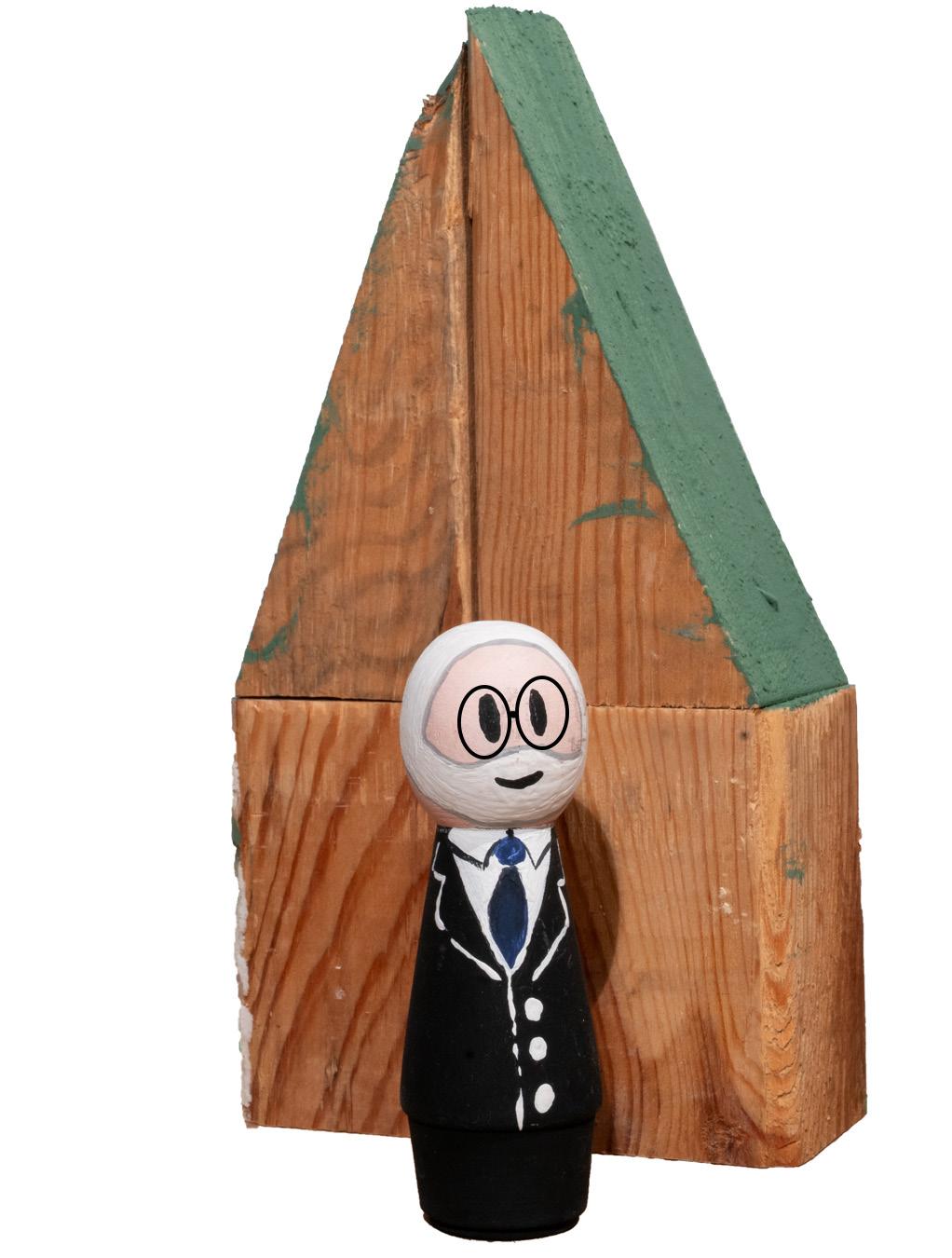



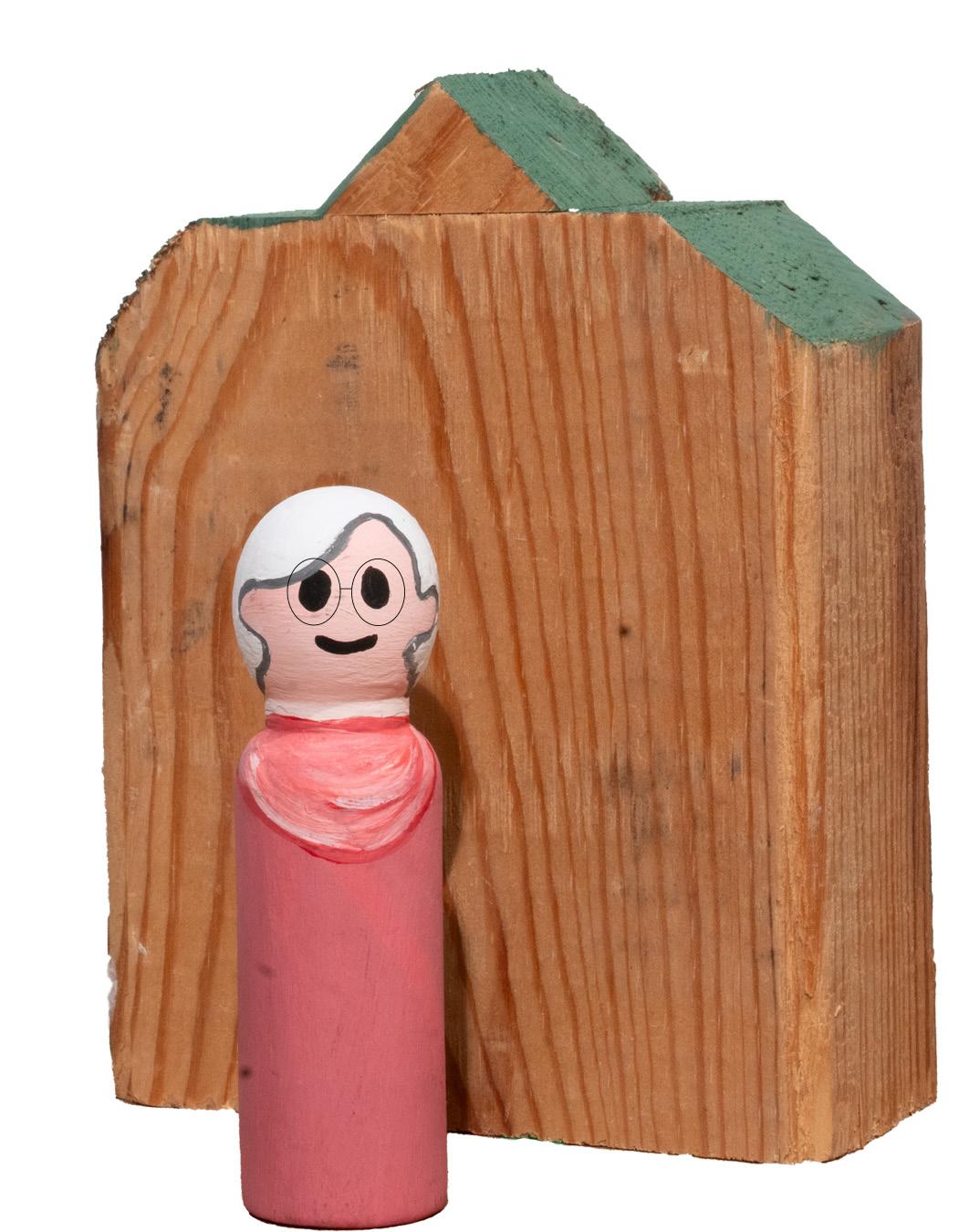
Location: east and southeast
Landmarks: Capen Park, Tolton Regional Catholic High School, MU South Farm Research Center, Stadium 14 Cinema, Columbia Sports Fieldhouse Council member: Betsy Peters







By Tyler White
What neighborhoods are the most prominent in your ward?
I live in East Campus. I run into neighbors that are either a lot of college students who come and go, and they’re pretty funny, but they come and go. Then there’s a lot of professors and retired professors. Shepard (Boulevard) is probably the most active. They have a picnic. They have movie nights. They decided to redo their front entry on Shepard, so they put some trees in, and they do a lot of mulching. And once or twice a year, I’ll see some emails saying we need people to come out and mulch, or need people to plant flowers, so they’re pretty active.
What are defining characteristics of the neighborhoods in the Sixth Ward?
I think knowing the neighbors, knowing each other. (It’s) the fact that they do know each other and that they know who maybe
needs a little bit more help, or needs some help getting the roll carts out or that that’s been taken care of, or when they’re out of town and these kids belong to this house.
How has your ward come together to face challenges?
They’ll get together for meetings. They ask to meet with me; mainly developers, if it’s a problem. We have one coming up in the next few weeks, from one of the newer neighborhoods. They’ve met with each other, they’ve met with me, they've met with the city. They’ve looked up the ordinances, they’ll come and enlist their concerns.
How do your neighbors connect?
People that have the same interests. They will have neighborhood picnics, so if you want to meet the neighbors, you can come and meet the neighbors. That's what I see. I presume they do it in East Pointe. I know they do it at Shepard, and they do it over my neighborhood.


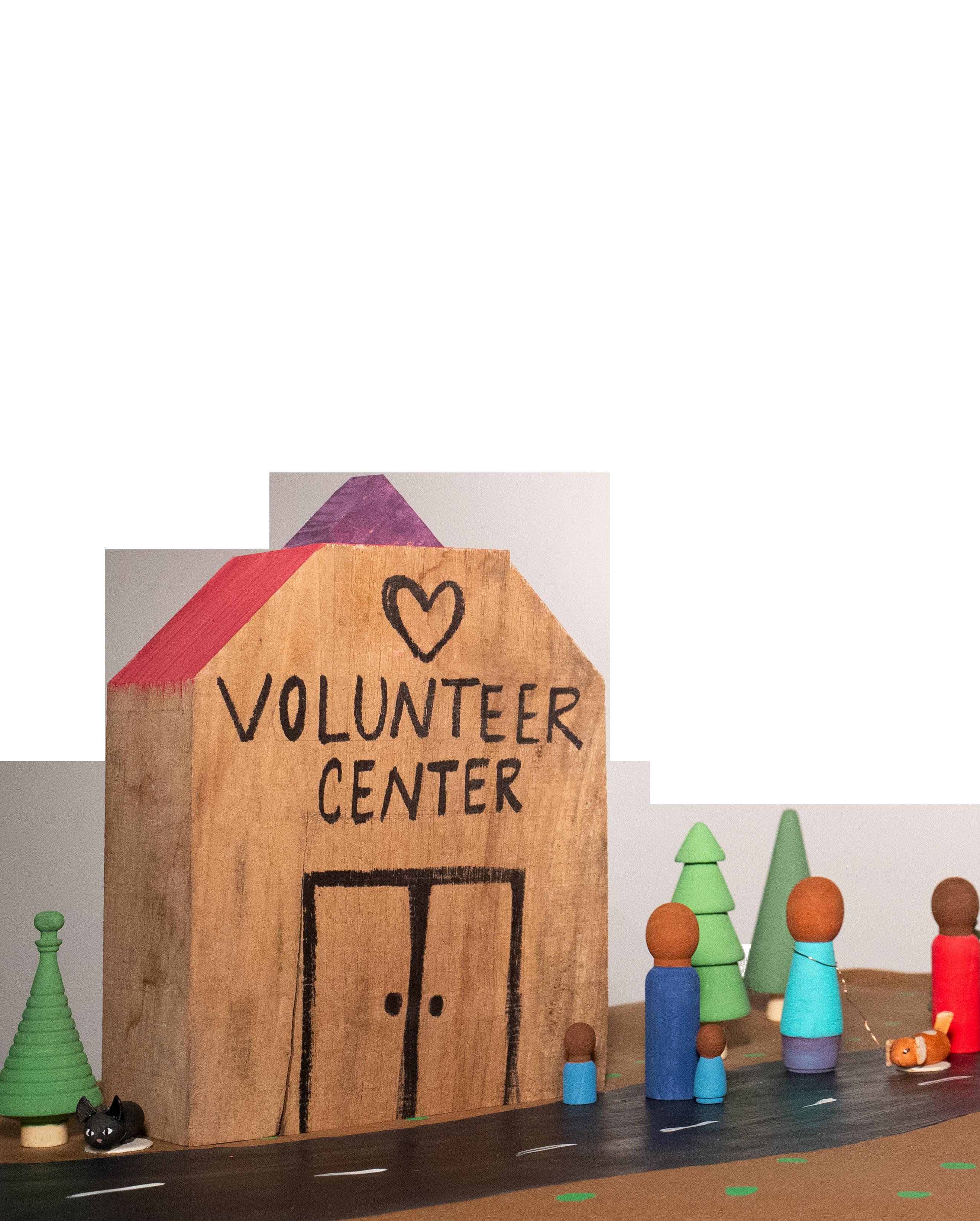
There are so many ways to serve your fellow neighbor.
BY ALEX GOLDSTEIN
Wanting to do good with like-minded people? Volunteering is one of the easiest ways to get involved in any neighborhood. Columbia is a city where many people volunteer, says Leigh Kottwitz, neighborhood services manager at the city of Columbia Housing and Neighborhood Services Division. The division has its own volunteer program where people are connected with various government projects around the city. “We never run out of things,” Kottwitz says, “If a volunteer comes to us, we’re going to find a way to get them connected in a way they can help our city.”
Volunteers at The Food Bank of Central and Northeast Missouri served a total of 71,042 hours in 2023. Those interested can sign up for
shifts in the Volunteer Room to prepare food for special events or mobile markets, or meet neighbors face-to-face by helping out at The Food Bank Market, which is open throughout the week.
Hours: Tues.–Fri., 10 a.m. to 4 p.m.; Saturday, 10 a.m. to 2 p.m. (market) or Mon.–Fri., 8 a.m. to 5 p.m. (food bank)
Get there: 705 Business Loop 70 W. (market) or 2101 Vandiver Drive (food bank)
Interested? Call 573-447-6620, visit sharefoodbringhope.org or email volunteer@sharefood bringhope.org.
The CoMo Mobile Aid Collective’s Mobile Soup Kitchen is part of its mutual aid efforts to feed people in need around the city, especially the unsheltered community. The collective’s food team serves at least 240 meals every week during spring, summer, fall and three days a week in winter.
Hours: The mobile kitchen operates on Mondays and Wednesdays (and Fridays in winter).
Interested? Visit comomobileaid.org or email hello@comomobileaid.org.
Social justice
City of Refuge is the comprehensive resource center for refugees in Columbia, Volunteer Coordinator Lauren Walter says. Volunteers can teach driving lessons, be an “English buddy,” stock donations or help run its youth programs.
“My favorite thing about what I do is that I could get to connect people to people,” Walter says. “It’s a way to love your neighbor.”
Hours: Mon.–Fri., 9 a.m. to 4 p.m.
Get there: 10 N. Garth Ave.
Interested? Fill out an application at cityofrefuge columbia.org.
Heart of Missouri Court Appointed
Special Advocates does extensive advocacy work for children in foster care across the state. Anyone who is over the age of 21 can complete an interview and 30 hours of volunteer training to get started. Services can include visiting the child and family members and writing reports for the juvenile court judge.
Hours: Mon.–Fri., 9 a.m. to 5 p.m.
Get there: 105 E. Ash St., Suite 102 Interested? Fill out an application at mo-heartofmissouri .evintosolutions.com/VolunteerApplication.
Show Me Central Habitat for Humanity allows volunteers to help with home construction, home repair or assist at one of Habitat’s home improvement ReStores.
Hours: Tues.–Sat., 8:30 a.m. to 4 p.m.
Get there: 1305 Business Loop 70 E. Interested? Find volunteer information at showmehabitat.org.
Climate/environment
COMO Trail Association helps keep the trails in Boone County beautiful. Volunteers are always needed for trail cleanup days throughout the year. Interested? Check out upcoming trail workdays at comotrails.org or email info@comotrails.org.
The Missouri Conservation Corps focuses on promoting environmental awareness and engaging residents in service to protect the climate. The corps recently planted 200 trees at Gans Creek Recreation Area on Oct. 30. Interested? Fill out an interest form at missouriconservationcorps.org and select Volunteer Sign-up.
The Missouri Department of Conservation offers volunteer opportunities at nature centers, shooting ranges and outdoor education centers.
Get there: Central Regional Office, 3500 E. Gans Road
Interested? Visit mdc.mo.gov/contact-engage/ volunteering.
Boone County Animal Care and Jenny’s Wildlife Wonderland are both run out of Jennifer Romesburg’s home. Volunteers can care directly for found stray cats and wildlife, foster cats or anything in between, Romesburg says.
Interested? Fill out a volunteer survey at boonecountyanimalcare.com, email jennyswildlife@gmail.com or find Jenny’s Wildlife Wonderland on Facebook.
Most volunteering work at the Central Missouri Humane Society typically includes walking dogs, socializing the animals outdoors or collecting donations from businesses around Columbia. Ultimately, volunteers will be helping prepare rescued animals for their future lives as successful pets.
Hours: Mon.–Fri., noon to 6 p.m., Saturday, noon to 5 p.m., Sunday, noon to 3 p.m.
Get there: 616 Big Bear Blvd.
Interested? Submit a volunteer application at cmhspets.org/volunteer.
The city of Columbia’s Engagement and Public Communication Division houses the city’s Community Connectors Program, which was established in 2024 and focuses

on facilitating dialogue between community members and city government.
Get there: 701 E. Broadway
Interested? Check out Community Connectors under the Engagement and Public Communication section of como.gov/city-managers-office.
Not just time, but money too
If you’re looking for ways to give back but don’t have the time to invest in a consistent volunteer position, opening up a fund through the Community Foundation of Central Missouri could be for you. Professionals offer advice on investment and fund management, grant guidance and support.
Hours: Mon.–Fri., 9 a.m. to 5 p.m.
Get there: 2635 S. Providence Road, No. 104 Interested? Visit cfcmfoundation.org to start setting up a fund.
CoMoGives offers people the opportunity to raise funds for a nonprofit on its behalf. Those interested can set up their own donation page for an affiliated nonprofit. Interested? Check out the toolkit at comogives.com/p/p2p-toolkit.

Keep it short and shoveled Understanding how to maintain lawns and sidewalks helps avoid costly citations — and a not-so-neighborly side-eye. If your lawn grass spills past 12 inches, the city may trim it back — and fine you for it. And in winter, an unshoveled sidewalk can cost homeowners $500 a day. In fiscal year 2024, the city addressed nearly 6,000 residential issues, including 1,364 overgrown lawns.
For residents in apartment complexes, keeping track of trash and delivery boxes is also important, as cluttered hallways violate fire codes and pose safety risks during emergencies. Nealy Simms

These neighbors are making their blocks into homes — inside and out.
BY NEALY SIMMS
Third places — those community spaces not related to where we go every day for work or school — are vanishing, leaving holes in the social and cultural lives of our neighborhoods. Across Columbia, residents are revamping boulevards, trails and parks into third spaces that give people a sense of pride in their neighborhoods. From fresh garden blooms and benches in once-empty lots to new markers that honor neighborhood history, local volunteers are building public spaces inspired by the cultural identities that shape their communities.
“I often think about a lot of service that people do behind the scenes, and how no one ever sees those things when it comes to taking care of our right of way in these public spaces,” says Leigh Kottwitz, the acting director for the city’s Housing and Neighborhood Services.
In May, at the corner of Garth Avenue and Sexton Road, members of the Ridgeway Neighborhood Association rolled up their sleeves and planted 21 trees funded by a Love Your Block grant from the city. The grant, awarded by Bloomberg Philanthropies, allowed Columbia to distribute 12


mini-grants for neighborhood revitalization projects throughout the city. “We saw this wonderful layering of partnerships,” says Stephen Bybee, the project director for the Missouri Conservation Corps, which collaborated with the neighborhood association.
Columbia is home to over 3,800 acres of green spaces. At the Missouri Conservation Corps, Bybee is committed to building a community around restoring the area's native habitats by removing invasive species, which can help better the environment and the wider community. “We're hoping that we can transform those spaces into a place that neighbors feel like they can come to and build a stronger connection within that neighborhood or within that community,” Bybee says.
The Love Your Block mini-grants funded a variety of projects. Flower Folk turned rubble and weeds into a West Ash neighborhood refuge where neighbors can relax on benches surrounded by nodding flower beds. Using funds from the Love Your Block grant, the Noble Court Neighborhood Watch Group installed a bronze plaque recognizing Columbia’s first Black neigh-

borhood and memorializing Lewis Monroe Noble, the community's founder.
The city's Adopt-A-Spot program offers another path to creating attractive third spaces. With nearly 30 years of success, the program sends volunteers to over 100 locations across the city. Kottwitz sends participants to areas near their homes or workplaces, where they beautify and maintain the adopted spaces.
In fiscal year 2024, over 8,000 volunteers hauled 10,291 bags of litter from parks, roads and streams, spent 672 hours sorting hazardous waste and kept 105 sites clear across Columbia.
Behind every transformed corner stands someone willing to rally neighbors, navigate city permits and show up season after season. “We have to have people in these neighborhoods willing to lead and organize a project,” Kottwitz says. “That’s where we see these things happen.”
Love Your Block grants supply funding for resident-led neighborhood revitalization projects up to $2,500. Find information at CoMo.gov/volunteer or by calling 573-874-7499.
The Missouri Conservation Corps is a volunteerbased group that encourages citizen involve ment. A list of events can be found at missouri conservationcorps.org.


Pistachios are the star ingredient in Dubai chocolate bars. They add a rich, nutty flavor that offsets the creamy milk chocolate and crunchy knafeh.


From croissants to bonbons, local shops are serving up their take on the viral Dubai chocolate bar trend.
BY MARISSA HORN
You know a food trend has staying power when it makes the jump from influencer videos to grocery store shelves. That’s the case of the so-called Dubai chocolate bar, which began as a baker’s pregnancy craving in 2022.
This summer, it became mass-marketed when Lindt released its own version. But for those who aren’t perennially online, you might wonder what a Dubai chocolate bar is.
It originated from British-Egyptian baker Sarah Hamouda. While operating her Dubai-based chocolatier business, she had a specific hankering for pistachio and knafeh — a layered, crispy Middle Eastern dessert made from shredded dough, ricotta cheese, sugar syrup and other ingredients. With the help of Filipino chef Nouel Catis, she turned it into a product and released it through her business.
Soon after, people were trying to recreate the concoction online. In December 2023, the chocolate went viral as influencers filmed their own videos taste-testing the dessert. When the chocolate bar started trending, it became known online as the Dubai chocolate bar.
There are four main ingredients that combine to form the smooth, nutty taste and crunchy texture: chocolate, knafeh, tahini and pistachios — which are the
real star of the show. The nuts are transformed into a creamy filling by combining other ingredients such as pure pistachio paste, milk and sugar.
These three local Columbia businesses are offering spin-off Dubai chocolate creations to follow the trend and fulfill their consumers’ appetites.
What to try: Dubai Chocolate Croissant Price: $8.95
Located downtown, this artisan bakery is known for its croissants, says Carlos Giraldo, who is a part of the family-owned business. His wife was the one to come up with the idea for a Dubai chocolate-inspired one.
“She thought that it is better to combine the Dubai chocolate and croissant,” Giraldo says. “At this moment, it is our bestseller.”
You can try this flaky and fluffy pastry that has a pistachio cream filling, rich chocolate and knafeh to replicate the Dubai chocolate bar’s filling.
Address: 904 Elm St., Suite 100 Hours: 7 a.m. to 4 p.m. Tues.-Fri.; 8 a.m. to 4 p.m.
Saturday and Sunday
What to try: Dubai Chocolate Bon Bons Price: $3.50 each
Hoping to give locals with the chance to try the viral chocolate without having to pay $15 or more for a full-sized bar, the owner of Tsokolate, Jannah Sanchez, makes her own Dubai chocolate bonbons by hand.
These bite-sized chocolates are made with dark chocolate and feature the recognizable pistachio cream with phyllo dough inside. Sanchez sells her chocolates at the Columbia Farmers Market with the aspiration of sharing her Filipino culture with locals.
“A lot of people don’t know that a Filipino came up with it,” Sanchez says. “I want Filipinos to be proud of the fact that Filipinos came up with something that is now well known around the world.”
Address: 1796 Ash St. (farmers market) Hours: 9 a.m. to noon Saturday
CAFE
What to try: Golden Dubai Strawberries Price: $14.99
This family-owned cafe offers a variety of Dubai chocolate-inspired menu items. One

unique take on the trend are the Golden Dubai Strawberries.
Tania Johnson, aunt to cafe owner Rafael Bobea, came up with the idea of bringing the chocolate to their business and creating their own personal take on it.
The Golden Dubai Strawberries are inspired by the cafe’s signature Iced Dulce De Leche Latte. The strawberries come in a cup with pistachio cream, kataifi — shredded phyllo dough — and chocolate drizzled on top. To include individuals who aren’t fans of pistachios, it has the same option without the pistachio cream drizzle, featuring Nutella instead.
Address: 214 S. Eighth St. Hours: 8 a.m. to 4 p.m. Mon.-Fri. and 9 a.m. to 3 p.m. Saturday
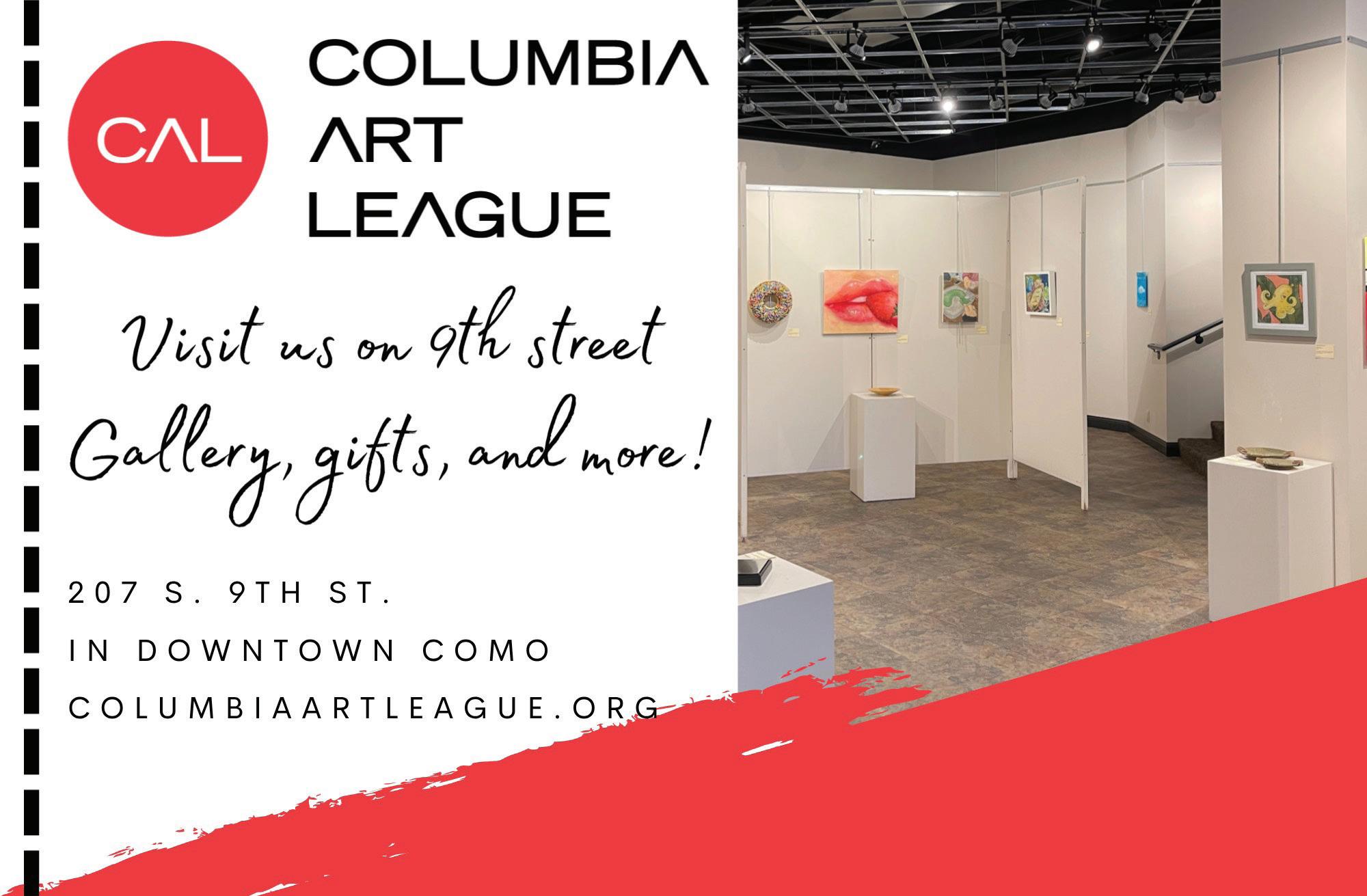
by


Vox talked to public health experts about what’s behind the county’s falling STI rates.
BY SOPHIE AYERS
A multitude of people and organizations have been working to make access to sexual health care cheaper and easier in Boone County. And it’s working.
Boone County STI cases have been on the decline this year, and local health department experts say low-cost care is the reason. Between 2023 and 2024, gonorrhea cases fell by a quarter, and syphilis cases fell by over a third.
Tracey Bathe is the prevention and investigation manager for Columbia/ Boone County Public Health and Human Services. She manages public health initiatives that have contributed to lowering overall rates of chlamydia, gonorrhea, HIV and syphilis cases in the county.
Bathe and her team oversee contracts that include grants for HIV case management, disease intervention specialists and high impact HIV prevention. In conjunction with the Show Me Condoms initiative, these programs have
Stephens College and Moberly Area Community College can receive the $20 resident testing by showing their student IDs.
Show me safe sex practices
Columbia houses a rural PrEP clinic that offers prescriptions and medical assessment for PrEP — a medication for HIV-negative people that prevents transmission — at no extra cost to residents. The rural PrEP clinic works with providers to offer low-cost options for patients wanting to take PrEP. The health team follows up with people who test positive to offer treatment and contact former sexual partners (with anonymity, of course).
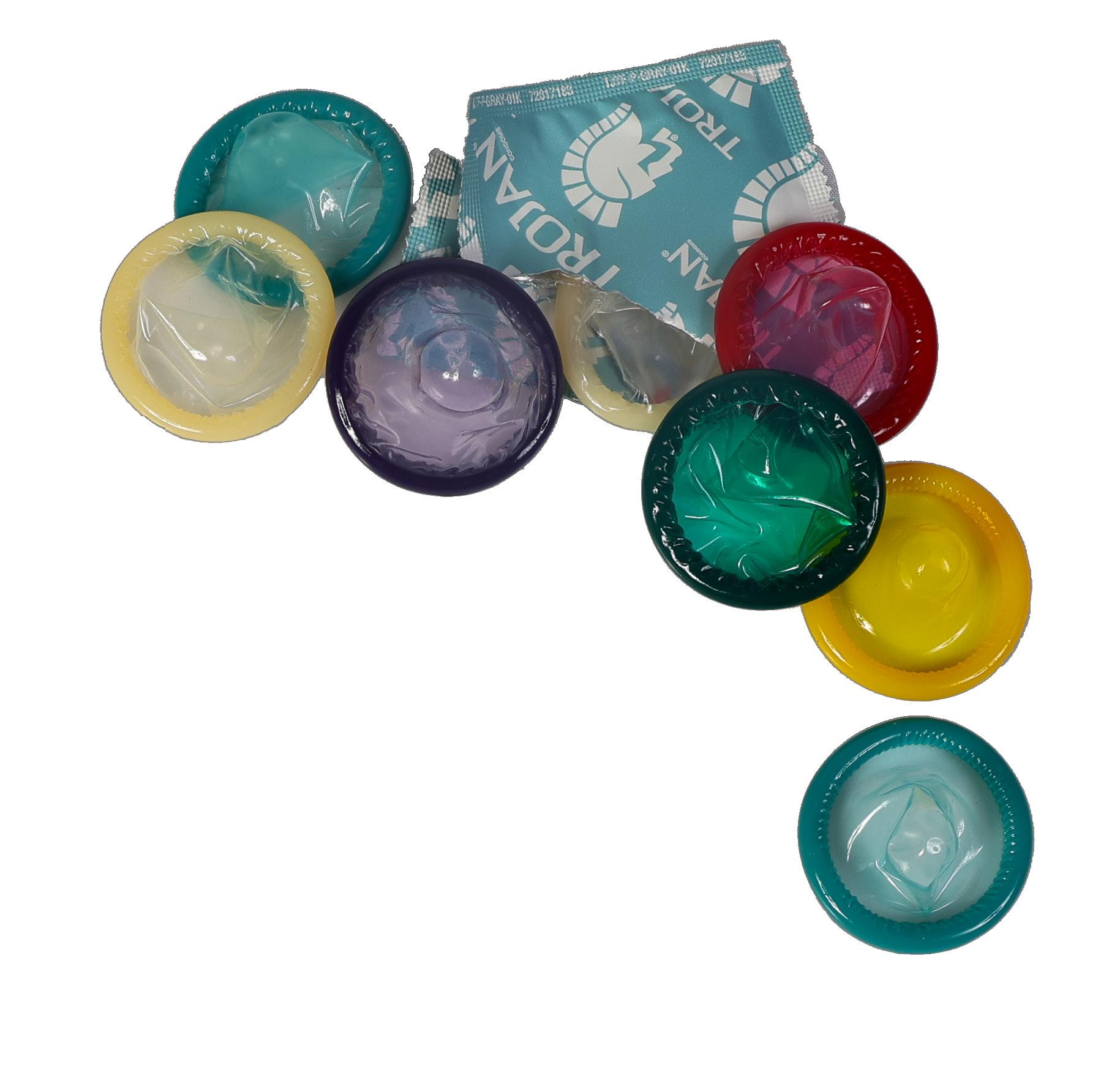
For residents in 37 Missouri counties (including Boone), Show Me Condoms will mail free condoms, dental dams and lube directly to your door in discreet packaging.
for condoms, dental dams and lube — discreetly packaged and distributed for safe sex. Formed in 2017, the initiative extends its network to 37 counties as a way to destigmatize proper prevention. “We want to make sure that there are no barriers to people who would like to have condoms, but perhaps there’s a stigma or shame to asking for them,” Bathe says. “We have them available where people can pick them up and not have to ask anyone for them.”

The silver lining is that with proper treatment, symptoms don’t last forever. “When you start treatment, eventually you become undetectable,” Bathe says. “Your viral load has suppressed so much that you cannot transmit it to someone else. That means we work really hard for the people who do test positive to stick with their treatment and take it regularly and stay what’s called ‘virally
Although rapid testing at the clinic is for HIV and syphilis, urine testing for other STIs, such as chlamydia and gonorrhea, are offered as well. Urine test results come back about one week after testing, while the HIV and syphilis rapid test results come back in about 15 minutes. Bathe recommends sexually active people get tested every three months. Show Me Condoms operates in Columbia as a free mailing service
Cody Jenkerson, HIV health program coordinator at Columbia/Boone County Public Health and Human Services, says outreach is an important part


of ensuring the sustainability of these programs. The Show Me Condoms team in Boone County hands out posters, stickers and pins to spread the word and prevent the spread of STIs.
“We want to make sure that people who might not otherwise have access to our services are able to access our services,” Jenkerson says. “We know that not everybody is going to be able to make it into a clinic, especially during that nine-to-five time. So, we’re looking at creative solutions to reach people where our services aren’t accessible.”
Anyone having sex, even with that perfected roll-on condom trick or dental dams, can get an STI. But when you add intoxication to the mix, things can get sticky (and not in a good way).
“We’re seeing that a driver of syphilis is methamphetamine use,” Bathe says. “Methamphetamine works in a way that people’s inhibitions go down, which is what happens with alcohol and other party drugs — but there is something
Bathe recommends sexually active people get tested every three months.
These local clinics offer reducedor low-cost STI testing.
Planned Parenthood 711 N. Providence Road; 9 a.m. to 5 p.m., Monday through Saturday (Wednesday open at 10:30 a.m.); prices depend on several factors, but financing services are available.
Educate, educate, educate
Want to learn more? Just show up at the door of Columbia/Boone County Public Health and Human Services or at your university’s student health clinic, and feel free to ask questions. The city and county health department closely monitors sexually transmitted disease surveillance reports, which can be found on the city of Columbia’s website.
Show Me Condoms offers free condoms, dental dams, lube and at home testing HIV kits via snail mail. Pop into Planned Parenthood, MU Health Care or the Columbia/Boone County Public Health and Human Services office to pick up a few free condoms. If going incognito is more your style, order condoms directly from the Show Me Condoms website. And if you’re concerned about your sexual health, your local clinics have your back.
euphoric where they may have more sexual partners.”
Young adults are statistically, and unsurprisingly, the most at-risk group in Boone County for contracting STIs. Those ages 19 to 24 are almost twothirds more likely to contract an STI than those ages 25 to 34 in Boone County.
Through the MU Health Care’s student services, students at the University of Missouri are allowed to get one free STI screening for chlamydia and gonorrhea each academic year. Mizzou’s Wellness Resource Center hosts free STI screenings once a semester in conjunction with Columbia/Boone County Public Health and Human Services. This aims to serve the population most vulnerable to STI transmission: college-aged students.
“We will have students as they’re leaving say, ‘I really appreciate that you guys do this,’ ’’ says Kelsie Gibler, program coordinator at the wellness center. “We’re a little short staffed, but we try to do as much as we can.”
Columbia/Boone County Public Health and Human Services 1005 W. Worley St.; 9 a.m. to 5 p.m., Monday through Friday; appointments are needed during regular business hours; $20 for Boone County residents or students with student ID, $40 for noncounty residents.
Spectrum Health Care
1123 Wilkes Blvd.; regular appointments: 9 a.m. to noon and 1-5 p.m., Monday through Thursday, walk-ins: Spectrum After Dark, 4-8 p.m., Tuesday and Thursday; price depends on several factors, but financing services are available.

Three Columbia programs keep environmental learning alive for the children who will inherit the consequences of climate change.
BY ACIYA EL TAJOURY
Climate change affects us all, so we should all learn how to combat it, right?
The reality is that sustainability education is often reserved for those who can afford it, and amid funding freezes for after-school programs, this continues to be true. A total of $6.8 billion in funding was withheld from federal K-12 programs for this coming academic year, sending schools into “triage mode” as they decide which programs to cut.
The funding freeze affects educator training and recruitment, English learner support, migrant education and literacy grants and student enrichment and after-school programs. Because of this, climate education opportunities and other vital programs are expected to take a hit.
“They’re going to inherit this problem,” says Ragan Webb, elementary science coordinator for Columbia Public Schools. “They are the future generations of advocates for science and climate action.”
Vox spoke with local educators to see how they provide nature education to underserved youths amid the potential loss of climate education funding.
Be resourceful
City Garden School is a private, tuition-based school serving K-8 students in a Waldorf-inspired structure.
This includes its outdoor campus and classrooms at Camp Takimina, which incorporates nature into classes such as organic chemistry, botany and “shelters
Photography by Kenzie Ripe
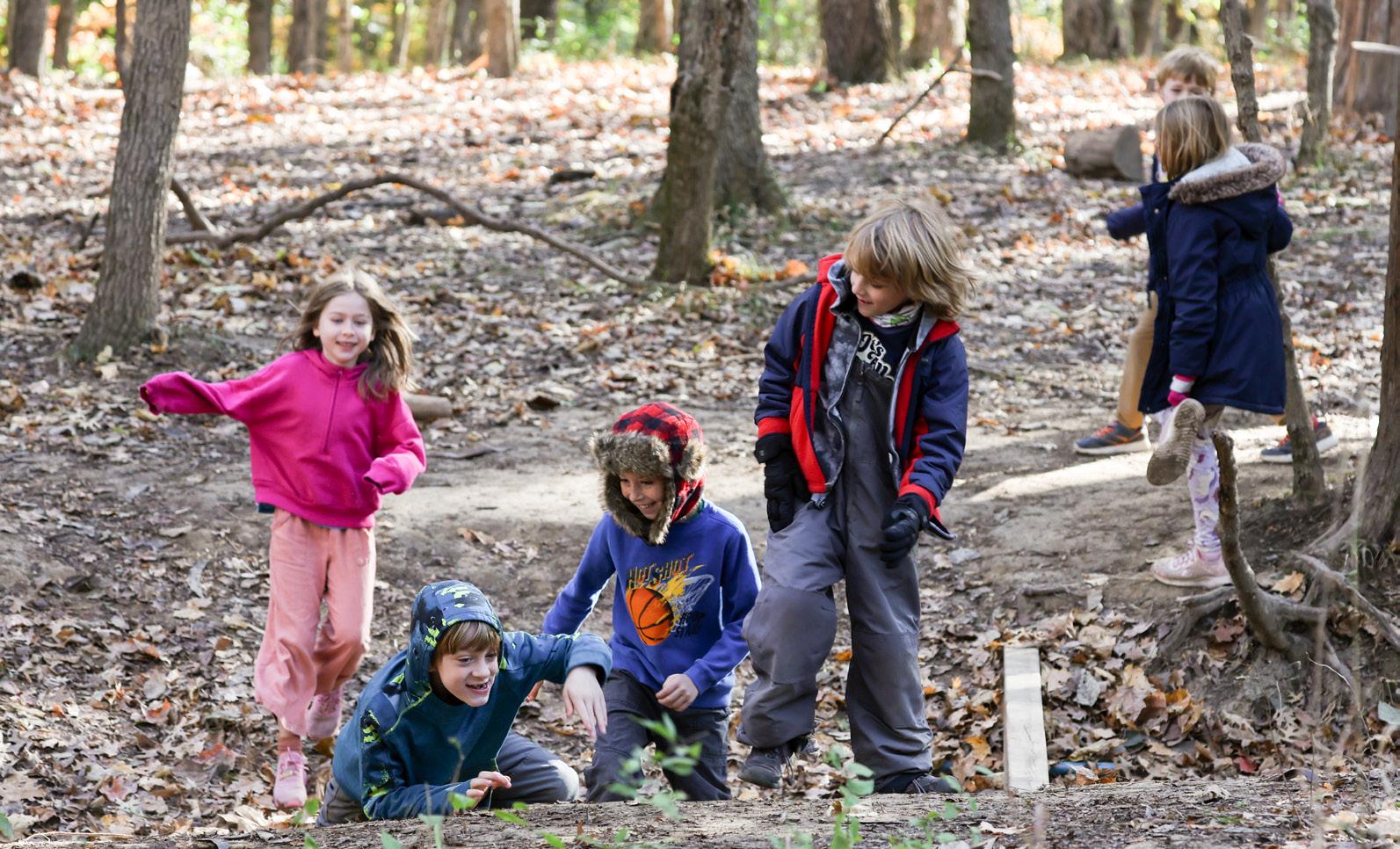
and dwellings.” If there’s one thing it has learned as one of the more affordable private schools in Columbia, it’s that resourcefulness goes a long way. That’s why parents can volunteer — doing everything from custodial work to assisting in the classroom — five hours a month in exchange for a tuition reduction. “We have to get really resourceful in covering our budget, but we do work really hard to keep our tuition as low as possible,” says Dawn Brown, head of City Garden School.
Know your audience
Boone County Nature School acts as a partnership between Columbia Public Schools, the Missouri Department of Conservation and six Boone County school districts. The nature school is incorporated into the curriculum for all public schools, meaning it’s able to provide these educational opportunities free of charge to students. At Boone County Nature School, educators focus on age-appropriate nature and climate education.
“They’re egotistic when they’re young,” Ragan Webb says, “so we start with how it affects them.”
Students go on field trips provided by the district, which starts with a trip to the Columbia Audubon Nature Sanctuary in second grade, where they study birds and learn about the ecosystem. They also visit the Columbia Center for Urban Agriculture in third grade, where
Getting outside is a pillar of the education at City Garden School, which allows kids to explore the wilderness and get their hands dirty.
Here’s the 101 on a couple of common alternative school structures.
WALDORF: This holistic learning philosophy is based on the educational principles of Rudolf Steiner, who emphasized the development of intellectual, artistic and practical skills with a focus on imagination and creativity.
NATURE SCHOOL: This educational approach immerses children in a natural environment for some, or most of, their learning time.
they have a more agricultural-oriented outdoor experience.
“I think as a public school system, we can give kids multiple, varying opportunities with outdoor or environmental education,” Webb says. “(It) helps level the playing field a little bit and gives kids experiences in the outdoors that they maybe wouldn’t have otherwise.”
Columbia STEM Alliance is a nonprofit that partners with Columbia Public Schools to provide STEM programs for Columbia youths. Program coordinator Caitlin Nichols says the most important aspect of her work is believing in the youth she serves.
“(We) eliminate the myths that surround them of ‘oh well, you have to be ridiculously intelligent to do STEM.’ ” Nichols says, “and have the conversation to the children of ‘you really just have to be interested.’ ”
The STEM Alliance is not focused solely on nature and sustainability education, but sustainability has become a recurring theme. This includes last year’s sustainability-in-the-home focus for Kids in STEM and its Fix-it Fair program, which teaches kids to fix broken items instead of disposing and repurchasing. “We make it fun, and we make it free, and we make it accessible,” Nichols says. “They have what it takes. They just need someone to sit them down and say, ‘hey, you got this.’ ”
Building a budget — and sticking to it — is no easy task. This is what local financial experts recommend for starting a spending plan.
BY ALEX GOLDSTEIN
Inflation, interest rates, tariffs, housing prices — it’s almost impossible to escape the daily barage of news about the economy. Americans spend nearly four hours a day thinking about their finances, according to research from Empower, a financial services company. About 54% of respondents say they are thinking about money more often than they did last year, reflecting an increase in financial anxiety as a whole. One of the ways you can counter the anxiety felt is learning more financial information. To get you started, Vox asked five Columbia experts in financial planning about which factors we should all be considering when planning our personal budgets and managing our bank accounts.
Understand where your money goes “People forget to put the coffee in the budget, the eating out with a friend in the budget, and then it just becomes, ‘Well, where did my money go?’ ” says Natasha Harris, owner of Victory Finances. “If you have Starbucks daily, you need to account for the daily Starbucks. There is no shame in tracking your money because you need to be aware of where it’s going and what it’s doing. Your spending is not so much a moral failure: It’s just that you need to make adjustments.”
There are plenty of apps and tools you can use to track your spending — some of these apps connect directly to your bank accounts, so you barely have to lift a finger.
From shopping sprees to filling up piggy banks, financial planning can be stressful. Even if it feels like your money is being shot out of a gun, there are resources that can help you manage money responsibly in the midst of uncertain times.
Focus on your financial self
“At the end of the day, the client is trying to figure out, ‘What do I do for me?’” says James Henderson, an investment advisor representative at Rock Bridge Financial Advisors. “They’re not worried about how the economy is being affected overall. My job is to take all those bigger things and break it down into how they are affecting you individually.”
Don’t fear the long-term picture
“Perhaps you’re 30 or 40 years old and a softening economy is not necessarily a bad thing. You can handle that downward trend for a little bit,” Henderson says. “We’re going to have a conversation about taking advantage of any kind of market decline. Let’s put some more money in, and let that work for you.”
While a September U.S. Bank survey reported strong indicators of shortterm financial security, respondents are also experiencing a “crisis of confidence” when it comes to long-term goals, such as buying a home or retiring comfortably. The economic factors that drive these achievements are often seen as being “beyond their control.” However, this survey also found that financial

planning can increase confidence and improve feelings of control.
Adapting to the economic world is key “It’s not about how much money people have, it’s about the behavioral change,” says Abed Rabbani, program director of the Personal Financial Planning Program at the University of Missouri and certified financial planner. “So I’m not going to blame the economy or lack of income or uncertainty. That’s beyond your control. What you can control is your reaction to those things. Once you have the spending plan, it needs to be flexible. We are living in uncertain times, so think about what can happen if you are working in a job sector with high turnover. If you have any spending plan, you cannot just rely on it for the rest of your life. Have a flexible budget that takes into account macroeconomic shocks. We are not in a recession yet, but if a recession happens, how am I going to change my behavior or spending habits?”
A June 2014 “Beyond the Numbers” report from the U.S. Bureau of Labor Statistics tracked how consumer spending across various categories, including food and homeownership, changes during periods of economic fluctuations. It found that the importance of food on the Consumer Price Index has been steadily decreasing, while the importance of renting has increased as people turn away from homeownership.
Don’t try to eat an elephant in one bite “When it comes to creating a budget, I tell people, ‘Let’s take it in pieces,’ ” says Sarah Moreau, director of ProsperU financial education classes at Central Bank. “We try to break it down into some basic steps that they can approach. It feels a whole lot more manageable to handle things as a checklist as opposed to this gigantic project.”
A budget is for everyone
“Sometimes we get in our heads: ‘I don’t have enough money to budget,’ or ‘I have enough money, I don’t need to worry about a budget,’ ” Moreau says. “I don’t think that’s true on either side. If you feel like you don’t have enough money to budget, it’s about directing

our dollars and focusing on covering the unexpected. On the other hand, are you really maximizing what your money can do for you if you’re just spending it and hoping for the best?”
Central Bank’s ProsperU program offers free financial literacy services in Columbia, Kansas City, Springfield and online. It’s open to anyone in the community and ranges from financial literacy classes for area nonprofits and businesses to one-on-one sessions.
Budgeting should become a habit
“If you have an extra $100 a month that you can pay down on something, or save, start at $50 a month, and then get comfortable with $50, and then move it to $65, and then get comfortable with $65 with the ultimate goal of getting to $100,” says Mary Dorn, assistant professor of finance at Columbia College . “If you can get it that way, it’ll stick. Don’t start the gym and try to run 5 miles three days in a row. You’ll quit by day four. What matters is you keep trying.”
According to Pew Research Center data, while a majority of people create budgets, less than a quarter actually stick to them. Many report overspending as the main issue. Investopedia suggests the 50/30/20 plan to keep on track: dedicate half of your income toward necessities, 30% to discretionary spending and 20% to savings and debt. Another method, which Dorn always emphasizes, is paying yourself first, essentially prioritizing savings, debt, housing and other personal necessities before anything else.
Try one of these five free financial planning resources.
InCharge Debt Solutions
Educational resources organized by state: incharge. org/debt-relief/ credit-counseling/ missouri
Love Columbia Information library with budget and credit building coaching: lovecolumbia.org/ finances
MU’s Office for Financial Success Resources for students: financialsuccess. missouri.edu
National Foundation for Credit Counseling Budget assistance, debt assessment and counseling: nfcc.org
ProsperU at Central Bank Financial education and assistance: events. centralbank.net/ prosperu/columbia

Your curated guide of what to do in Columbia this month.
BY ACIYA EL TAJOURY AND MATTHEW OSTHOFF
Tell Me on a Sunday
This one-woman show tells the story of an English girl who emigrates to the United States and follows her heart from New York to Hollywood and back again. The 1977 musical features music by award-winning composer Andrew Lloyd Webber. Its 1985 Broadway run featured Bernadette Peters. 7:30 p.m. Dec. 4-6 and 11-13; 2 p.m. Dec. 7 and 14, Talking Horse Productions, $20; $18 students and seniors, 573-607-1740
Amahl and the Night Visitors
Enjoy a fresh spin on festive entertainment with this one-act Landlocked Opera production. The 1951 opera follows a boy and his mother who encounter three kings en route to visit the newborn Jesus. 7 p.m. Dec. 5 and 8 p.m. Dec. 6, First Baptist Church, $15; $5 for students, landlocked operainc@gmail.com
Masters Exhibit
The 12th annual Masters Exhibit returns with an opening reception during the Dec. 5 First Friday from 6-8 p.m. The exhibit features the work of widely recognized and underrated 20th century artists. Starts Dec. 5 , 11 a.m. to 6 p.m. Tues-Sat., Sager Reeves Gallery, free, 573-442-4831
The Creative Age
Celebrate “The Creative Age” art show at the Columbia Public Library. It features paintings created by adults 55 and older during an eight-week class. All are welcome to see the work of the Columbia and Fulton classes. 1-2 p.m. Dec. 6, Columbia Public Library, free, 573-443-3161
Nutcracker! Magical
Christmas Ballet
The holidays aren’t complete without a performance of The Nutcracker. Featuring

an international cast, puppetry and European artisan-crafted costumes and sets, this ballet set to Tchaikovsky’s score is a classic for a reason. 7 p.m. Dec. 10, Jesse Auditorium, $62.66-$86.46, 573-882-3061
World AIDS Day
Celebration & Fundraiser
Join Spectrum Healthcare for a celebration honoring World AIDS Day, featuring 2024’s Miss Gay Metropolitan America, Veronika Versace. Proceeds will benefit Spectrum Healthcare’s HIV education, prevention and sexual health initiatives
The District’s Living Windows Festival returns to downtown shops, featuring open houses, holiday decor and performances from Santa’s helpers, such as these festive folks from My Secret Garden in 2024. 6-8 p.m. Dec. 5, The District, free, 573-442-6816
across mid-Missouri. 7-11 p.m. Dec. 1, Arch & Column Pub, free, 573-514-7312
Kwanzaa and Black-Owned Business Expo
Visit the city’s annual Kwanzaa celebration, which fosters unity and community with entertainment, food and booths highlighting local Black-owned businesses. To register your business for the expo or learn more about the event, contact Recreation Specialist Jay Bradley at jay.bradley @como.gov. 2-5 p.m. Dec. 6, Armory Sports and Recreation Center, free, 573874-7460
Bundle up to view downtown’s seasonal decorations while enjoying a free ride in a horse-drawn carriage courtesy of The District. The weekend rides start at 4 p.m. and are free on a first-come first-served basis. Rides depart from the Serendipity Salon and Gallery parking lot. 4-7 p.m. Nov. 29, Dec. 6-7, 13-14 and 20-21, Serendipity Salon and Gallery, free, 573-442-6816
If you’re looking for unique handmade gifts, check out City of Refuge’s third annual holiday market for items made by local artisans and refugees, food, hot beverages and a visit from Santa. Shop for gifts or just revel in the season’s spirit. All proceeds go toward City of Refuge refugee care services and programming. 10 a.m. to 4 p.m. Dec. 6, City of Refuge, 10 N. Garth Ave., free, 573-454-1552
Join author Jodie Jackson and former Columbia city manager Ray Beck in a conversation about Jackson’s book Fingerprints and Footprints: Ray Beck’s Columbia . The biography tells the story of Beck, who helped shape Columbia, from downtown development and Stadium Boulevard to annexations that
tripled the size of the town. Noon Dec. 9, The State Historical Society of Missouri, free, 573-882-7083
Enjoy an evening of holiday magic at the Village of Cherry Hill’s annual Magic Tree Lighting Festival. Featuring face painting, balloon animals, food trucks and more, this yuletide event kicks off the holiday season in the brightest way possible. 5-8 p.m. Dec. 4, Village of Cherry Hill, 4200 Merchant St., free, randalwfletcher@gmail.com
Learn how cultures around the world celebrate the Christmas season with this family-friendly, interactive museum event that’s part of Boone County History & Culture Center’s monthly Boone Youth Explorers. Activities include decorating paper gingerbread ornaments, creating origami cranes, making Christmas crackers and many more. 10 a.m. to noon, Dec. 13, Boone County History & Culture Center, free, 573-443-8936
Spend a Wednesday in December helping your neighbors. This 12-hour fund and food drive for the Food Bank for Central and Northeast Missou-
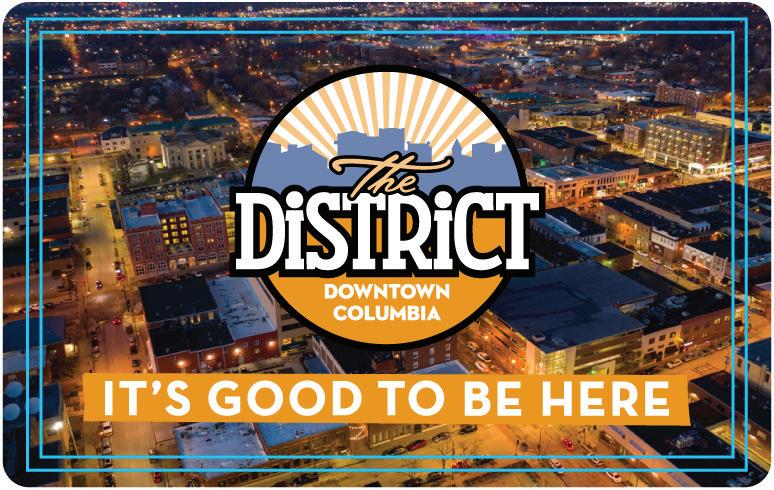

ri includes fire trucks, music and an appearance from Santa. 6 a.m. to 6 p.m. Dec. 17, Columbia Mall, free, 573-474-1020
Giving Tuesday Barn Party
Warm chili on a chilly day at the barn in Columbia’s Agriculture Park is a great way to kick off Columbia Center for Urban Agriculture’s fundraising campaign. The annual CoMoGives supports a variety of nonprofits throughout Columbia. Donations given during the event are matched. RSVP at columbiaurbanag.org. 4-6 p.m. Dec. 2, Columbia’s Agriculture Park, free, 573-514-4174
Holiday Treats Workshop
Join Back 2 Basics Cooking and chef Ashley Nichols for a hands-on culinary experience creating five different holiday delectables, including Oreo balls and peppermint bark, along with decorating cookies and cupcakes. 2-4:30 p.m. Dec. 14, CoMo Cooks Shared Kitchen, 14 Business Loop 70 East, $155 for two people, 573-268-2248
A Very Cozy, Very Classic, Very Fireside Holiday Special
You know the scene: holiday tunes playing by
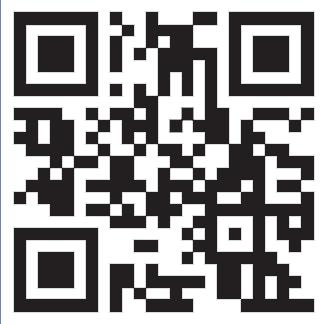


the fireside, friendly-faces abound, with a certain holiday magic in the air. Hosted by local thespian David McSpadden, this holiday concert features performances by Rochara Knight & The Honey Doves, Cabaret for a Cause and The Quorus, along with special guest appearances from Meredith Shaw, Audra Sergel, Trent Rash, Robin Anderson and Michele Curry. It’s part of the Blind Boone Piano Concert Series. 7 p.m. Dec. 4, The Montminy Gallery, $25; $15 students, 573-443-8936
In celebration of the 25th anniversary of Joel and Ethan Coen’s acclaimed film O Brother, Where Art Thou?, the Columbia group River Ghost Revue and a selection of guest musicians will channel the Soggy Bottom Boys as they perform favorites from the film and Grammy Award-winning soundtrack. 8 p.m. Dec. 12, Cafe Berlin, $10, facebook.com/ cafeberlincomo/events
This holiday tradition is returning for its 17th year of infectious holiday spirit blended with St. Louis-style brass music. This year’s Brasstravaganza features special guest vocalist Emily Wallace, who is known for her soulful voice. 8 p.m. Dec. 12, Rose Music Hall, $13.30, 573-874-1944
Head to the First Baptist Church to enjoy a night of holiday music in the warm glow of candlelight. Part of the Odyssey Chamber Music Series, it highlights harpist Maria Duhova Trevor and her husband, cellist Kirk Trevor. Also featured are the Miyamoto-Tsuruta Piano Duo as well as Curtis Pavey and Helena Hyesoo Kim in Joo-Hye Lee’s compilation in her “Christmas Fantasy.” 7 p.m. Dec. 12, First Baptist Church of Columbia, $25; $5 students; free for children under 12, 573-825-0079
Local garage rock band Pink Houses will perform at Rose Music Hall, joined by fellow Columbia-based bands The Crab and Recent News. 8 p.m. Dec. 13, Rose Music Hall, $13.30, rosemusic hall.com
Cheese & Sauerkraut 10 miler
The rules of this 10-mile run are simple: Predict your finishing time. The closest predictor wins cheese and the predictor who is farthest off wins sauerkraut. Sponsored by the Columbia Track Club, sign up for this annual run on RunSignUp or just sign up on race day. 8:30 a.m. Dec. 6, McBaine Trailhead, free, rgay@bjc.org

PHOTOGRAPHY BY HANNAH
Colin LaVaute strums the guitar as he leads an Oct. 9 music rally for Owen Ramsingh, longtime Columbia resident and head of security for both Rose Music Hall and The Blue Note. In September, he was detained by U.S. Immigration and Customs Enforcement. “Owen is fortunate that he has so many people that care about him and so many people that are fighting to bring him home because there’s plenty of people that have been detained that don’t have that benefit,” LaVaute says. Ramsingh’s family and friends are awaiting answers on when he will be released from detainment. Updates can be found on the Facebook group Bring Owen Home.
